The extensive practice provided by NCLEX Questions can help students build confidence and alleviate test anxiety.
NCLEX Stress, Crisis, Anger, and Violence Questions
Stress, Crisis, Anger, and Violence NCLEX Practice Questions
Question 1.
The nurse cares for a middle-aged client with a below-the-knee amputation. Which statement indicates the need for further assessment of the client’s body image?
(a) “When I get my prosthesis, I want to learn to walk so I can participate in walkathons.”
(b) “I hope to get skilled enough at using my prosthesis to help others like me adjust.”
(c) “Whenever I start to feel sorry for myself, I remember that my buddy died in that accident.”
(d) “I hope I can handle having a prosthesis, but I’m really wondering what my wife will think. ”
Answer:
(d) “I hope I can handle having a prosthesis, but I’m really wondering what my wife will think. ”
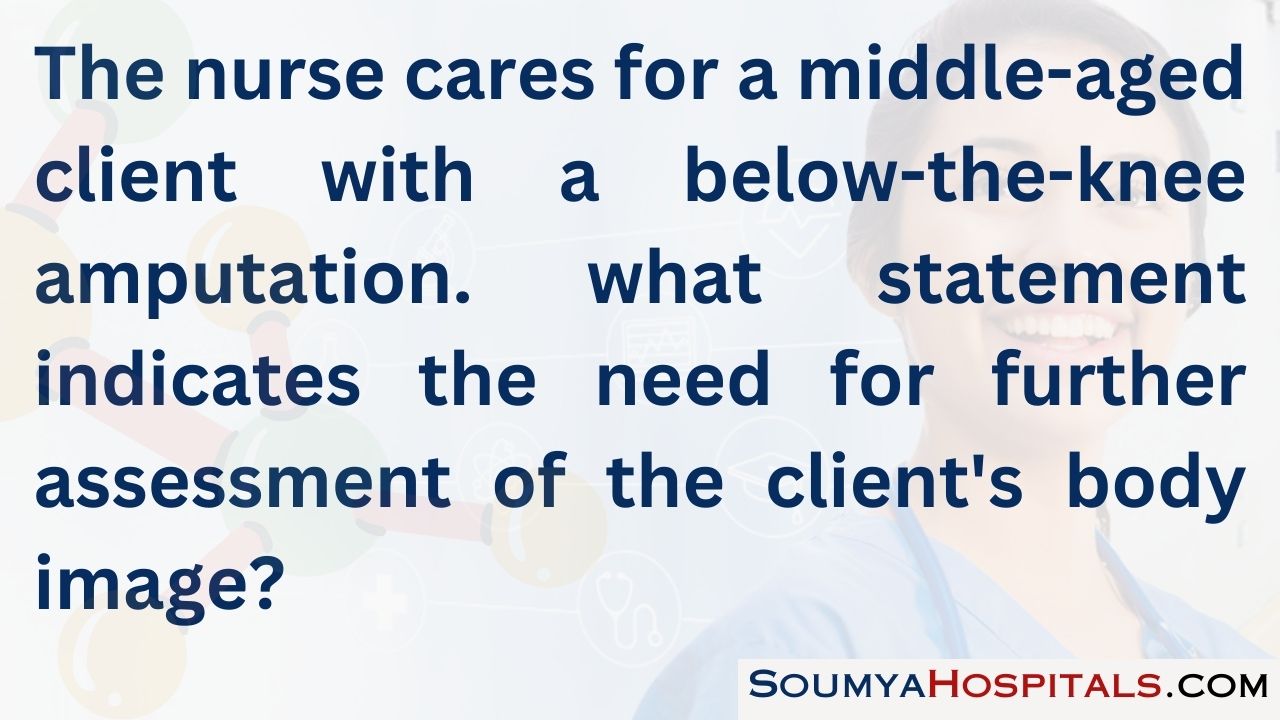
Explanation:
The client expressing doubts about his wife’s response to his amputation, as well as possible doubt on his part, is still struggling with body image issues. Looking forward to participating in walkathons and helping others indicate plans for the future that imply an acceptance of his amputee status. Remembering that his friend died in the accident that caused his amputation indicates that the client is aware that there was a worse end result to the accident than his amputation.
Question 2.
A 75-year-old client is newly diagnosed with diabetes. The nurse is instructing him about blood glucose testing. After the session, the client states, “I can’t be expected to remember all this stuff.” The nurse should recognize this response as most likely related to which factor?
(a) moderate to severe anxiety
(b) disinterest in the illness
(c) early-onset dementia
(d) normal reaction to learning a new skill
Answer:
(a) moderate to severe anxiety
Explanation:
Anxiety, especially at higher levels, interferes with learning and memory retention. After the client’s anxiety lessens, it will be easier for the client to learn the steps of the blood glucose monitoring. Because the client’s illness is a chronic, lifelong illness that severely changes lifestyle, it is unlikely that the client is uninterested in the illness or how to treat it. It is also unlikely that dementia would be the cause of the client’s frustration and lack of memory. The client’s response indicates anxiety. Client responses that would indicate lessening anxiety would be questions to the nurse or requests to repeat part of the instruction.
Question 3.
A client in a general hospital is to undergo surgery in 2 days and is experiencing moderate anxiety about the procedure and its outcome. What should the nurse do to help the client reduce anxiety?
(a) Distinct the client with games and television.
(b) Provide reassurance that the client that will come through surgery without incident.
(c) Explain the surgical procedure to the client and what happens before and after surgery.
(d) Ask the surgeon to refer the client to a psychiatrist who can work with the client to diminish anxiety.
Answer:
(c) Explain the surgical procedure to the client and what happens before and after surgery.
Explanation:
An explanation of what to expect decreases anxiety about upcoming events that could be seen as traumatic by the client. Distraction, such as with games or television, only decreases anxiety temporarily and does not fulfill the client’s need for information about the procedure. Reassurance about an uncomplicated outcome is not appropriate; the nurse cannot guarantee that the client will come through surgery without problems. Referring the client to a psychiatrist is not indicated for moderate, expected preoperative anxiety.
Question 4.
Anxiety occurs in degrees, from a level that stimulates productive problem solving to a level that is severely debilitating. At a mild, productive level of anxiety, the nurse should expect to see what cognitive characteristic of mild anxiety?
(a) slight muscle tension
(b) occasional irritability
(c) accurate perceptions
(d) loss of contact with reality
Answer:
(c) accurate perceptions
Explanation:
With mild anxiety, perceptions are accurate. Slight muscle tension reflects a motor response. Occasional irritability is an emotional response. Loss of contact with reality is a cognitive characteristic of severe anxiety.
Question 5.
As a client’s level of anxiety increases to a debilitating degree, the nurse should expect which psychomotor behavior as indicating a panic level of anxiety?
(a) suicide attempts and violence
(b) desperation and rage
(c) disorganized reasoning
(d) loss of contact with reality
Answer:
(a) suicide attempts and violence
Explanation:
Suicide attempts and violence are psychomotor responses to a panic level of anxiety. Desperation and rage are emotional responses. Disorganized reasoning and loss of contact with reality are cognitive responses.
Question 6.
Nursing interventions with an anxious client change as the anxiety level increases. At a low level of anxiety, what is the primary focus of intervention?
(a) taking control of the situation for the client
(b) learning and problem solving
(c) reducing stimuli and pressure
(d) using tension reduction activities
Answer:
(b) learning and problem solving
Explanation:
Mild anxiety motivates the client to focus on issues and resolve them. Therefore, learning and problem solving can occur at a mild level of anxiety. Taking control for the client is reserved for a near-panic level of anxiety. Severe anxiety interferes with reasoning and functioning. Therefore, reduc-ing stimuli and pressure is crucial at a severe level. Tension reduction is appropriate at a moderate level to help the client think more clearly and engage in problem solving.
Question 7.
When coping becomes dysfunctional enough to require the client to be admitted to the hospital, the nurse expects that the client would be exhibiting what behaviors?
(a) objective and rational problem solving
(b) tension reduction activities and then problem solving
(c) anger management strategies with no problem solving
(d) minimal functioning with new problems developing
Answer:
(d) minimal functioning with new problems developing
Explanation:
Minimal functioning, which can cause new problems to develop, is a reflection of dysfunctional coping. The ability to objectively and rationally solve problems demonstrates adaptive coping. Tension reduction activities demonstrate palliative coping. However, such activities alone do not solve problems; they must be followed by problem solving. Anger management alone may prevent new problems, such as violence toward oneself or others, but it does not solve problems directly. It is considered maladaptive coping.
Question 8.
A client has severe anxiety after hearing about a death in the immediate family. She is not able to focus on the questions asked of her. She will not eat, drink any fluids or attend to her personal care. At night, she is found outdoors without a coat in winter looking for answers to what she could have done differently for the deceased individual. Which instruction by the nurse is best?
(a) “You’ve got to take care of yourself.”
(b) “Here, drink this glass of milk.”
(c) “He wouldn't want to see you like this.”
(d) “When do you think you can take care of yourself?”
Answer:
(b) “Here, drink this glass of milk.”
Explanation:
When a client is experiencing severe anxiety, the nurse should use firm, short, and simple statements. Telling the client to drink milk is firm, short, and simple and provides the client with some protein. The statement, “You’ve got to take care of yourself” suggests that the client can solve the problem. Telling the client that the deceased person would not like to see the client like this puts the blame on the anxious client. Asking the client, “When do you think you can take care of yourself?” implies that the client can make that decision. Clients with severe anxiety cannot make decisions, so providing an answer as to when they can perform self-care would not be possible at this time.
Question 9.
Which client statement indicates that the client has coped effectively with a relationship problem?
(a) “My wife will be happy to know that I can spend less time at work now.”
(b) “My wife and I are talking about our likes and dislikes in activities.”
(c) “I can understand how my wife and I see things differently.”
(d) “We are really listening to each other about our different views on issues.”
Answer:
(d) “We are really listening to each other about our different views on issues.”

Explanation:
The client’s statement that he and his wife listen to each other reflects improved efforts at communicating about issues. The other statements provide some insight into the need for better communication. However, there are steps along the way to coping effectively with the problem.
Question 10.
In an ongoing assessment, the nurse should identify the client’s thoughts and feelings about a situation in addition to what other factors?
(a) whether the client’s behavior is appropriate in the context of the current situation
(b) whether the client is motivated to decrease dysfunctional behaviors
(c) which of the client’s problems have the highest priority
(d) which of the client’s behaviors necessitates a safety plan
Answer:
(a) whether the client’s behavior is appropriate in the context of the current situation
Explanation:
Assessment examines the client’s thoughts, feelings, and behaviors within a context. Whether the client’s behavior is appropriate for the situation is important assessment data. Setting priorities is part of making nursing diagnoses and planning; motivation to change and identifying the need for a safety plan are part of the planning stage.
Question 11.
What short-term goal for a client hospitalized with a stress-related disorder is most realistic?
(a) The client will demonstrate a positive self-image.
(b) The client will describe plans for how to get back into school.
(c) The client will write a list of strengths and needs.
(d) The client will practice assertiveness skills in confronting his mother.
Answer:
(c) The client will write a list of strengths and needs.
Explanation:
Writing a list of strengths and needs is short term, achievable, and measurable. Achieving positive self-esteem would occur over the long term. Going to school involves complex future steps to a long-term goal. Using skills is likely to be stressful and is best attempted after the client has done a self-assessment.
Question 12.
A nurse is counseling a client with cancer who is experiencing anxiety. Which goal will provide the best long-term client outcome?
(a) Keep follow-up appointments with mental health providers.
(b) Understand medication effects and adverse effects.
(c) Take medication as prescribed.
(d) Solve problems independently.
Answer:
(d) Solve problems independently.
Explanation:
The ultimate outcome is to have clients solve problems by themselves, collaborating in their own care. Client follow-up with mental health providers, while desirable, does not ensure that the client will fully comply with treatment or medication. Knowledge of the medication’s effects and adverse effects and compliance can help the client, but it will not ensure success unless the client knows how to address and solve problems independently.
Question 13.
What area should the nurse focus on when integrating the concepts underlying the cognitive- behavioral model into a client’s plan of care?
(a) substitution of rational beliefs for self-defeating thinking and behaving
(b) insight into unconscious conflicts and processes
(c) analysis of fears and barriers to growth
(d) reduction of bodily tensions and stress management
Answer:
(a) substitution of rational beliefs for self-defeating thinking and behaving
Explanation:
Substituting rational beliefs is a major goal when using cognitive-behavioral models, which focus more on thinking and behaviors than feelings. Unconscious processes are the focus of psychoanalytic models. Analysis of fears and barriers to growth is the focus of developmental models. Tension and stress are targets of the stress models.
Question 14.
Which client statement indicates that the client has gained insight into his use of the defense mechanism of displacement?
(a) “I can’t think about the weekend right now I’ve got to study for the exam.”
(b) “I know I’m not good in sports, but I feel good about my grades.”
(c) “Now when I am mad at my wife, I talk to her instead of taking it out on the kids.”
(d) “For years I couldn’t remember being molested; now I know I have to face it.”
Answer:
(c) “Now when I am mad at my wife, I talk to her instead of taking it out on the kids.”
Explanation:
Displacement refers to a defense mechanism that involves taking feelings out on a less- threatening object or person instead of tackling the issue or problem directly. Talking to his wife directly reflects insight into the client’s use of the defense mechanism and his ability to overcome it. Not thinking about the weekend is suppression. Here, the client is focusing on the issue with the highest priority. Focusing on academic rather than athletic achievement is compensation, highlighting one’s streng ths instead of weaknesses. Not remembering the niolestation is repression.
Question 15.
In which situation can a client’s confidentiality be breached legally?
(a) to answer a request from a client’s spouse about the client’s medication
(b) in a student nurse’s clinical paper about a client
(c) when a client near discharge is threatening to harm an ex-partner
(d) when a client’s employer requests the client’s diagnosis to initiate medical claims
Answer:
(c) when a client near discharge is threatening to harm an ex-partner
Explanation:
Legally, there is a duty to warn a potential victim of a client’s intent to harm. Staff can be held accountable if the client injures the ex-partner and the staff failed to warn that person. The client’s permission is needed to share information with a spouse. Student papers should not contain identifying information. Release of information is made directly to the client’s insurance company, not to the employer.
Question 16.
A client is admitted after the police found the client sleeping in a car for three nights. The client says, “My spouse kicked me out and is divorcing me. It wasn’t my fault I was fired from work. My spouse and boss are plotting against me because I’m smarter than they are.” The client then pounds the table and says, “I’m not staying here, and you can’t stop me.” What should be included in the client’s immediate plan of care? Select all that apply.
(a) collateral information from the spouse an' boss
(b) anxiety and anger management
(c) appropriate housing
(d) divorce counseling
(e) assault and escape precautions
(f) suspiciousness and grandiosity issuies
Answer:
(b) anxiety and anger management
(e) assault and escape precautions
Explanation:
(b), (e) The client is showing increased anxiety and anger as well as refusing to stay in the hospital, which are immediate and crucial concerns at admission. The client is not likely to give permission to talk to the spouse and boss at this point. Housing issues and divorce counseling may be relevant before discharge, but not initially. Suspiciousness and grandiosity may be relevant after the client’s anxiety and anger are under control.
Question 17.
What is a crucial goal of therapeutic communication when helping the client deal with personal issues and painful feelings?
(a) communicating empathy through gentle touch
(b) conveying client respect and acceptance even if not all of the client’s behaviors are tolerated
(c) mutual sharing of information, spontaneity, emotions, and intimacy
(d) guaranteeing total confidentiality and anonymity for the client
Answer:
(b) conveying client respect and acceptance even if not all of the client’s behaviors are tolerated
Explanation:
The nurse is required to set limits on inappropriate behavior while conveying respect and acceptance of that person. Doing so conveys that the client is worthy without posing any harm or embarrassment to the client. Touch is a complex issue that must be used cautiously. Touch may be misinterpreted or misperceived by a client who has been abused or who has perceptual or thought disturbances. Mutual sharing reflects a social friendship, not a therapeutic one. Total confidentiality is not desirable. For example, treatment team members and insurance companies need selected information to ensure quality services.
Question 18.
An 18-year-old pregnant college student presented at the prenatal clinic for an initial visit at 14 weeks’ gestation. The client’s history revealed that she has taken fluoxetine 20 mg orally daily for post-traumatic stress disorder (PTSD) and depression. Her medication was recently increased to 40 mg daily because of reports of increased stress and suicide ideation. Which side effect of fluoxetine would the nurse judge to be the greatest risk for the client and her developing fetus at this stage in her pregnancy?
(a) insomnia
(b) nausea/anorexia
(c) headache
(d) decreased libido
Answer:
(b) nausea/anorexia
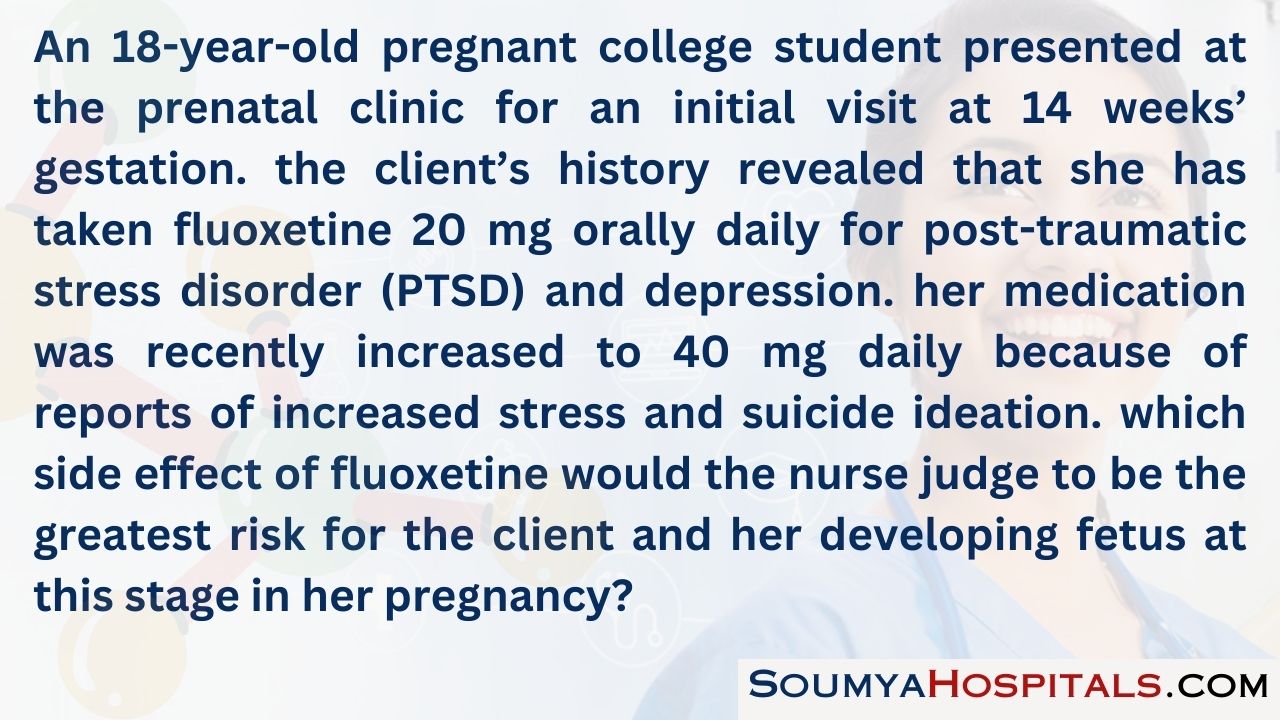
Explanation:
Growth of the fetus is important, so nausea and anorexia that would interfere with the young woman’s nutrition would cause the most harm to the developing fetus. It could also lead to electrolyte imbalance if she did not take in enough fluid. While insomnia could cause problems long term, this side effect could be mitigated through adjustment of the dosing time (earlier in the day), by decreasing the dosage to her former 20 mg daily, or by changing to every other day dosing of 40 mg, since fluoxetine has a long half-life.
Headaches are uncomfortable but can be treated with mild analgesics or other treatments, such as cold cloths, that would not harm the fetus. Decreased libido, while not enjoyable for the client or her sexual partner, does not pose any risks for the fetus.
Question 19.
Which probe should the nurse use to encourage client's evaluation of his or her own behavior?
(a) “I can hear that it’s still hard for you to talk about this.”
(b) “So what does this all mean to you now?”
(c) “What did you do differently with your coworker this time?”
(d) “What will it take to carry out your new plans?”
Answer:
(c) “What did you do differently with your coworker this time?”
Explanation:
Asking for descriptions of changes in behavior (what the client did differently) encourages evaluation. Conveying empathy, such as stating that it is still hard for the client to talk about it, encourages data collection. Asking for meaning helps with the nursing diagnosis. Asking the client about what it will take to follow out a plan is part of planning.
Question 20.
Even when the client understands problems and is motivated to change, the client may have fears about failing. Which intervention is most likely to facilitate change?
(a) reality testing about the need for change
(b) asking the client about fears that need to be overcome
(c) teaching new communication skills
(d) having client practicing new behaviors
Answer:
(d) having client practicing new behaviors
Explanation:
Practicing new behaviors builds confidence and reinforces appropriate behaviors. Reality testing, asking about fears, and teaching new communication skills are some of the many steps when trying out new behaviors.
Question 21.
A mastertomy is recommed for a 68-year old client diagonsed with breast cancer a week ago. when approached about giving conset for the mastermony the client says, "what's the use in trying to hsandle of the cancer ? It will just come back ! I can't Beside another thing having diabetes is enough. were you Im getting old. It would be different if I the nurse anger and had more energy." What should do?
(a) Accept the client's decision beacuse it is her right to choose to obtain treatment or not.
(b) Give to choose to obtain about the survial the client information about the survive rates the client who underwent.
(c) call he chapain to speak with the client about their her h0poless attitude about the future.
(d) Explore with the client her feeelings about the health problems and proposed surgery.
Answer:
(d) Explore with the client her feeelings about the health problems and proposed surgery.
Explanation:
While the client does have a right to accept or reject treatment, she has not explored her feelings, her possible mastectomy, or the future. The nurse should assist the client in exploring her feelings and moving toward a fuller understanding of her options. Giving the client survival rates indicates that the nurse feels she should have the surgery and negates her fears and concerns. While the chaplain might be helpful, this step should be done after the client has explored her feelings.
Question 22.
An 18-year-old client is recently diagnosed with leukemia. What is the most appropriate shortterm goal for the nurse and client to establish?
(a) accepting the client’s death as imminent
(b) expressing the client’s angry feelings to the nurse
(c) decreasing interaction with peers to conserve energy
(d) gaining an intellectual understanding of the illness
Answer:
(b) expressing the client’s angry feelings to the nurse
Explanation:
Diagnosis of a serious illness would be a shock to anyone but particularly a young person. Feelings of anger are normal and should be expressed. Gaining an intellectual understanding of his illness would also be necessary, but such learning will not take place if the client’s feelings have not been addressed.
There is no indication that the client needs to conserve energy because of the client’s condition, nor is it clear that death is imminent. Neither situation is likely at the point of first diagnosis unless the disease is well advanced, which is not indicated here.
Question 23.
The nurse has been asked to develop a medi-cation education program for clients with chronic mental illness in the rehabilitation program. When developing the course outline, which topic is most important to include?
(a) a categorization of many psychotropic drugs
(b) interventions for common side effects of psychotropic drugs
(c) the role of medication in the treatment of acute illness
(d) effects of combining common street drugs with psychotropic medication
Answer:
(b) interventions for common side effects of psychotropic drugs
Explanation:
The psychotropic drugs used to treat chronic mental illnesses have side effects that can lead to noncompliance. Therefore, teaching the clients measures to deal with the common side effects would be most important. Teaching should be focused on the need for compliance and the specific interests of the target audience. Teaching should concentrate on the medications commonly used to treat chronic mental illness, not on many psychotropic drugs or those used in acute illness.
Such topics as the role of medication in the treatment of chronic mental illness and the effects of using common street drugs with psychotropic medication should be discussed after the issue of compliance is addressed.
Question 24.
The health care provider (HCP) recommends that a client have a partial bowel resection and an ileostomy. Later, the client says to the nurse, “That doctor of mine surely likes to play big. I will bet the more he can cut, the better he likes it.” Which reply by the nurse is most therapeutic?
(a) “I can tell you more about the surgery if you like.”
(b) “What do you mean by that statement?”
(c) “Why don’t you think about getting a second opinion?”
(d) “Does that remark have something to do with the operation he wants you to have?”
Answer:
(b) “What do you mean by that statement?”
Explanation:
When the client seems to be questioning the HCP’goals, it is best for the nurse to present an open statement and ask what the client means. This technique helps the client express feelings. Telling the client about the surgery is less therapeutic when the client is upset. While it is the client’s right to get a second opinion, this suggestion does not address the client’s feelings. Making assumptions can also interfere with communication, especially if the assumption is incorrect.
Question 25.
A client becomes increasingly irritable after being diagnosed with cancer. The client is rude to visitors and pushes nurses away when they attempt to give medications and treatments. What should the nurse do when the client has a hostile outburst?
(a) Offer the client positive reinforcement each time the client cooperates.
(b) Encourage the client to discuss immediate concerns and feelings.
(c) Continue with the assigned tasks and duties as though nothing has happened.
(d) Limit visitation until the client is less irritable.
Answer:
(b) Encourage the client to discuss immediate concerns and feelings.
Explanation:
When the client has hostile outbursts, it is best for the nurse to help the client express feelings. This serves as a release valve for the client. Offering positive reinforcement for cooperation does not help the client express feelings appropriately. Continuing with assigned tasks ignores the client’s feelings and may lead to further escalation. Limiting visitation reduces the client’s support systems and does not address the underlying problem.
Question 26.
Arrangements are made for a member of the colostomy support group to meet with a client before bowel surgery. What is accomplished by having a representative from the group meet the client preoperatively?
(a) letting the client know that there are resources in the community that can help
(b) providing support for the health care provider’s (HCP’s) plan of therapy for the client
(c) providing the client with support and realistic information on the colostomy
(d) explaining that the surgery will not be disfiguring and that the client can lead a full life
Answer:
(c) providing the client with support and realistic information on the colostomy
Explanation:
Preoperative visits and talks with others who have made successful adjustments to colostomies are helpful and tend to make the client less fearful of the operation and its consequences. Knowing about resources in the community will be helpful as the client approaches discharge. Supporting the HCP is less important than supporting the client and giving the client information. The client will have a change in body image, with disfigurement due to the creation of a colostomy. However, the client should be able to lead a full life.
Question 27.
A nurse is working in the emergency department when a woman comes in reporting that she was notified that her husband was just admitted following an accident. The woman is pacing, tearful, and her attention span seems poor. The nurse recognizes that the woman is having moderate anxiety. What should be the nurse’s first response?
(a) “Hi! I’m really glad you are here. I work on this unit and was here when your husband came in. He was in really bad shape.”
(b) “Your husband is awake and stable right now. I’ll take you to his room.”
(c) “Your husband had an X-ray, and he might have a fractured femur. His hemoglobin and hematocrit are stable. He is diaphoretic. He has had an analgesic while awaiting an orthopedic consultation.”
(d) “You seem really nervous about all of this. Maybe you should complete the admission paperwork before seeing your husband.”
Answer:
(b) “Your husband is awake and stable right now. I’ll take you to his room.”
Explanation:
When people are experiencing moderate anxiety, their attention span is limited and they are only able to focus on immediate concerns, so being brief and concise with communication initially is best. Giving the client too many details, or using medical terms prior to her knowing the immedate condition of her husband, will just increase
anxiety. At this point she is also unable to focus on details such as paperwork as her immediate concern is her husband.
Question 28.
Which statement would lead the nurse to determine that a client lacks understanding of the client’s acute cardiac illness and the ability to make lifestyle changes?
(a) “I already have my airline ticket, so I won’t miss my meeting tomorrow.”
(b) "These relaxation tapes sound okay; I'll see if they help me.”
(c) “No more working 10 hours a day for me unless it’s an emergency.”
(d) “I talked with my spouse yesterday about working on a new budget together.”
Answer:
(a) “I already have my airline ticket, so I won’t miss my meeting tomorrow.”
Explanation:
Leaving the hospital and immediately flying to a meeting indicate poor judgment by the client and little understanding of what ‘festyle changes he client needs to make. The Other statements show that the client understands some of the changes that need to be made in order to decrease stress and lead a healthier lifestyle.
Question 29.
A client has been rehospitalized with a severe exacerbation of lupus. Her husband approaches the nurse and says, “My wife is scaring me. She says she doesn’t want to live with this illness anymore. Our kids are grown, and she feels useless as a mother and a wife. ” Which statements are the most appropriate responses to the husband? Select all that apply.
(a) “I’ll have a talk with your wife to see if she is suicidal.”
(b) “You need to be strong and optimistic when you are with her.”
(c) “I’m glad you shared this with me. I can imagine that this is scary for you.”
(d) “I’m sure she will feel differently when we get this episode under control.”
(e) “We can talk about what you can say to her that may help.”
Answer:
(a) “I’ll have a talk with your wife to see if she is suicidal.”
(c) “I’m glad you shared this with me. I can imagine that this is scary for you.”
(e) “We can talk about what you can say to her that may help.”
Explanation:
(a), (c), (e) Suicide is a risk with chronic illnesses. The husband needs validation of his feelings and support as well as suggestions for helping his wife with her concerns. Telling him to be strong and optimistic ignores the client’s needs. It is false to assume that the client will no longer be suicidal when the lupus is under control.
Question 30.
The client with kidney stones refuses to eat lunch and rudely tells the nurse to get out of the client’s room. Which response by the nurse is most appropriate?
(a) “I’ll leave, but you need to eat.”
(b) “I’ll get you something for your pain.”
(c) “Your anger doesn’t bother me. I’ll be back later.”
(d) “You sound angry. What’s upsetting you?”
Answer:
(d) “You sound angry. What’s upsetting you?”
Explanation:
The nurse’s best response is one that directly expresses the nurse’s observations to the client and offers the client the opportunity to talk about feelings or concerns to decrease somatization (the need to express feelings through physical symptoms). Leaving, offering to provide pain medication, and stating that anger does not bother the nurse ignore the client’s needs.
Question 31.
A client diagnosed with ulcerative colitis also experiences obsessive-compulsive anxiety disorder (OCD). In helping the client understand her illness, the nurse should respond with which statement?
(a) “Your ulcerative colitis has made you perfectionistic, and it has caused your OCD.”
(b) “There is no relationship at all between your colitis and your OCD. They are separate disorders.”
(c) “The perfectionism and anxiety related to your obsessions and compulsions have led to your colitis.”
(d) “It’s possible that your desire to have everything be perfect has caused stress that may have worsened your colitis, but there is no proof that either disorder caused the other.”
Answer:
(d) “It’s possible that your desire to have everything be perfect has caused stress that may have worsened your colitis, but there is no proof that either disorder caused the other.”
Explanation:
Though ulcerative colitis and OCD have some features in common, and stress can make both illnesses worse, there is no definitive cause-effect relationship between ulcerative colitis and OCD. Therefore, the only appropriate nursing response would be to acknowledge the effect of stress on both illnesses and indicate there is no proof that either illness causes the other.
Question 32.
A client receiving dialysis directs profanities at the nurse and then abruptly hangs his head and pleads, “Please forgive me. Something just came over me. Why do I say those things?” The nurse interprets this as which finding?
(a) neologism
(b) confabulation
(c) flight of ideas
(d) emotional lability
Answer:
(d) emotional lability

Explanation:
This type of behavior illustrates emotional lability, which is a readily changeable or unstable emotional effect. Neologism is using a word when it can have two or more meanings or a play on words. Confabulation involves replacing memory loss with fantasy to hide confusion; it is unconscious behavior. Flight of ideas refers to a rapid succession of verbal expressions that jump from one topic to another and are only superficially related.
Question 33.
On an oncology unit, the nurse hears noises coming from a client’s room. The client is found throwing objects at the walls and has just picked up the phone and is screaming, “How can God do this to me? It’s the third type of cancer I’ve had.
I’ve gone through all the treatment for nothing.” In what order of priority from first to last should the nurse make the interventions? All options must be used.
(a) “Tell me what you are feeling right now.”
(b) “Please put the telephone down so we can talk.”
(c) “I can hear how upset you are about cancer".
(d) "I wonder if you would like to talk to a member of the hospital clergy".
Answer:
(b) “Please put the telephone down so we can talk.”
(c) “I can hear how upset you are about cancer".
(a) “Tell me what you are feeling right now.”
(d) "I wonder if you would like to talk to a member of the hospital clergy".
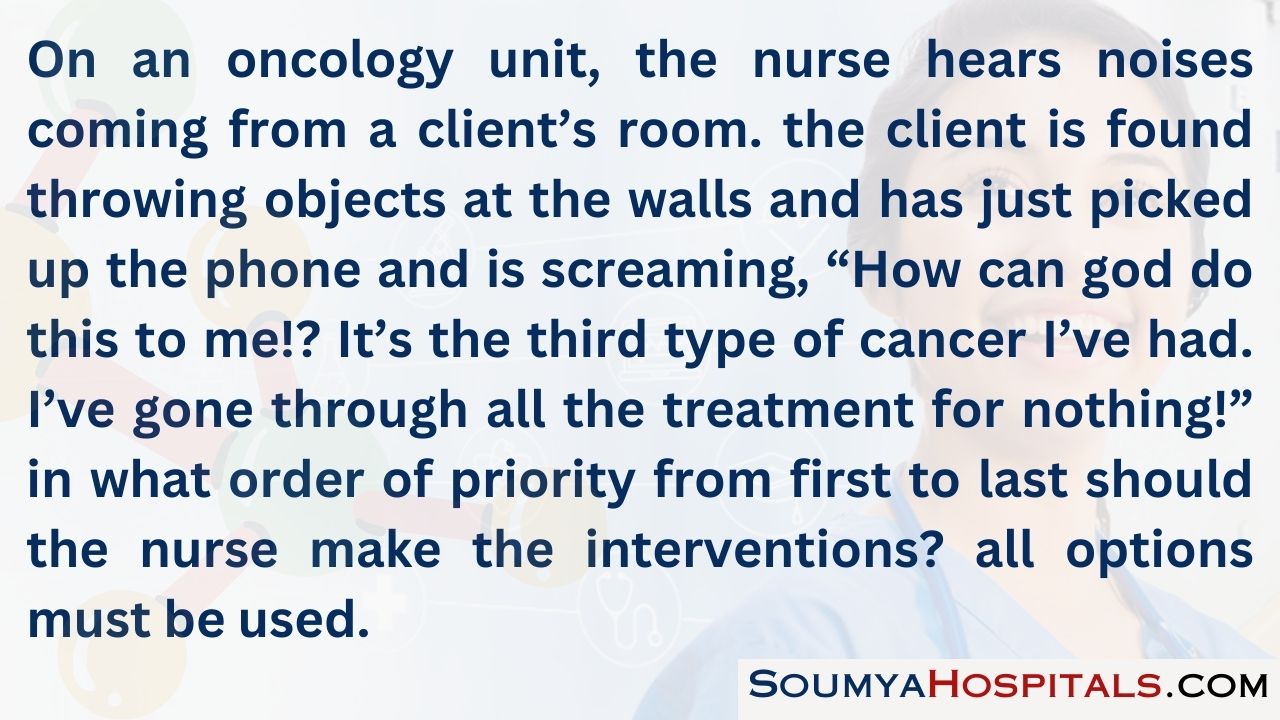
Explanation:
(b), (c), (a), (d) The first priority is a safe environment so the client and nurse are not hurt by the phone. Then, it is important to acknowledge the client’s anger to help diffuse it. As the client calms down, the nurse can explore the client’s feelings in more depth- Since the client implies anger at God, a clergy cons ult may be appropriate.
Question 34.
A client who has had AIDS for years is being treated for a serious episode of pneumonia. A psychiatric nurse consult was arranged after the client stated, “I’m tired of being in and out of the hospital. I’m not coming in here anymore. I have other options.” The nurse would evaluate the psychiatric nurse consult as helpful if the client makes which statements?
(a) “Nobody wants me to commit suicide.”
(b) “If I talk about suicide, I’ll be transferred to the psychiatric unit.”
(c) “I realize that I really do have more time to enjoy my family and friends.”
(d) “I would probably screw up suicide anyway.”
Answer:
(c) “I realize that I really do have more time to enjoy my family and friends.”
Explanation:
Focusing on enjoying time with family and friends conveys a renewal of hope for the future and a decreased risk of suicide. Simply saying that no one wants the client to commit suicide does not say the client does not want to do it. Avoiding a transfer to a psychiatric unit does not mean the client is no longer suicidal. Fear of not being successful with suicide usually is not a deterrent.
Question 35.
The nurse assists the client in responding to a loss. What is the best approach for the nurse to use with this client?
(a) Make sure the client progresses through all of the stages of the grief process.
(b) Encourage the client to work to resolve lingering family conflicts.
(c) Assist the client to engage in the work associated with the normal grieving process.
(d) Allow the client to express anger.
Answer:
(c) Assist the client to engage in the work associated with the normal grieving process.
Explanation:
Individuals progress through the stages of loss at their own pace. Not everyone experiences each phase, and no one can be forced to advance to the next stage until ready. The best approach for helping the client to work through the pain of loss is to assist the client in processing and engaging in the pain of loss. This process may involve working on family conflicts and/or anger issues, but it is not the primary goal.
Question 36.
The nurse working at the site of a severe flood sees a woman, standing in knee-deep water, staring at an empty lot. The woman states, “I keep thinking that this is a nightmare and that I’ll wake up and see that my house is still there.” Which crisis intervention strategies are most needed at this time? Select all that apply.
(a) Ask the client about any physical injuries she may have.
(b) Determine if any of her family are injured or missing.
(c) Allow the client to talk about her fears, anger,and other feelings.
(d) Tell her that groups are being formed at the shelter for flood survivors.
(e) Refer her to the shelter for dry clothes and food.
(f) Assess her for risk of suicide and other signs of decompensation.
Answer:
(a) Ask the client about any physical injuries she may have.
(b) Determine if any of her family are injured or missing.
(c) Allow the client to talk about her fears, anger,and other feelings.
(f) Assess her for risk of suicide and other signs of decompensation.
Explanation:
(a), (b), (c), (f) The immediate needs for this client are for safety and security, so it is important to assess for injuries, safety of her family, suicide risk, and signs of emotional decompensation. Needs for food, clothing, and support are important later, after safety and security are addressed.
Question 37.
The nurse is assessing a client who has just experience'd a crisis. The nurse should first assess this client for which behavior?
(a) effec tive problem solving
(b) level of anxiety
(c) attention span
(d) help seeking
Answer:
(b) level of anxiety
Explanation:
During the first phase of crisis, the client exhibits elevated anxiety. A client who can use problem-solving capabilities is not in crisis. A shortened attention span is characteristic of the fourth phase of crisis. Reaching out to others for help is indicative of the third phase of crisis.
Question 38.
The nurse is working with a family in crisis. What should the nurse do in order of priority from first to last? All options must be used.
(a) Make a plan for managing the crisis.
(b) Develop strategies to reduce symptoms.
(c) Assess the family's resources.
(d) Identify the family member in crisis.
Answer:
(d) Identify the family member in crisis.
(c) Assess the family's resources.
(b) Develop strategies to reduce symptoms.
(a) Make a plan for managing the crisis.
Explanation:
(d), (c), (b), (a) The nurse must first identify which member is exhibiting crisis symptoms. Next, the nurse identifies strategies to reduce the most severe symptoms. The nurse then assesses the family’s resources. The family member in crisis may have such overwhelming feelings that he or she is unable to identify or describe the feelings.
Question 39.
An anxious young adult is brought to the interviewing room of a crisis shelter, sobbing and saying that she thinks she is pregnant but does not know what to do. Which nursing intervention is most appropriate at this time?
(a) Ask the client about the type of things that she had thought of doing.
(b) Give the client some ideas about what to expect to happen next.
(c) Recommend a pregnancy test after acknowledging the client’s distress.
(d) Question the client about her feelings and possible parental reactions.
Answer:
(c) Recommend a pregnancy test after acknowledging the client’s distress.
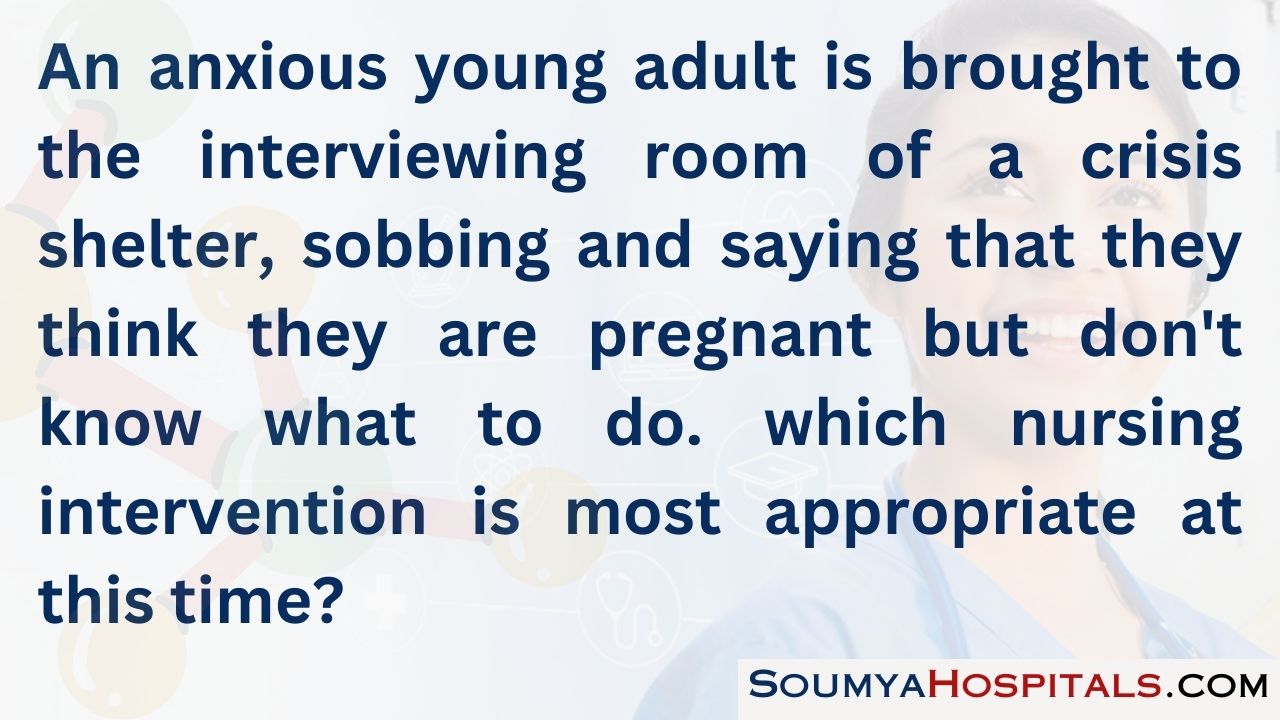
Explanation:
Before any interventions can occur, knowing whether the client is pregnant is crucial in formulating a plan of care. Asking the client about what things she had thought about doing, giving the client some ideas about what to expect next, and questioning the client about her feelings and possible parental reactions would be appropriate after it is determined that the client is pregnant.
Question 40.
A client who had been sexually assaulted as a young girl saw her assailant after 5 years. She cut her wrists and was brought into the emergency department by a family member who discovered her hiding on a closet floor. Which questions should the nurse ask to assess the client’s perception of this event? Select all that apply.
(a) “Has anything upsetting happened to you within the past few days or weeks?”
(b) “Who can you talk to when you feel overwhelmed?”
(c) “What was happening in your life before you started to feel like hurting yourself?”
(d) “Describe how you are feeling now.”
(e) “Who is available to help you?”
(f) “What helped you through difficult times in the past?”
Answer:
(a) “Has anything upsetting happened to you within the past few days or weeks?”
(c) “What was happening in your life before you started to feel like hurting yourself?”
(d) “Describe how you are feeling now.”
Explanation:
(a), (c), (d) In order to clearly define the problem, the nurse needs to assess the client’s perception of the precipitating events. The question of whether anything upsetting happened to her within the past few days or weeks, what was happening in her life before she started to feel like hurting herself, and requesting the client to describe how she is feeling all reflect how the client is perceiving the problem now. The questions about who can the client talk to when feeling overwhelmed, who is available to help her, and what has helped her during difficult times in the past are situational support assessment questions.
Question 41.
A 40-year-old client who is quite anxious says that she would “rather die than be pregnant.” Which response by the nurse is most helpful?
(a) “Try not to worry until after the pregnancy test.”
(b) “You know, pregnancy is a normal event.”
(c) “You’re only 40 years old and not too old to have a baby.”
(d) “I see you’re upset. Take some deep breaths to relax a little.”
Answer:
(d) “I see you’re upset. Take some deep breaths to relax a little.”
Explanation:
Because people in an emotional crisis find it difficult to focus their thinking, the goal is to return the client to noncrisis functioning. Pointing out and decreasing the client’s level of anxiety is the first step in attaining this goal. Telling an obviously distressed person not to worry is ineffective because it ignores the client’s distress and concerns. Although pregnancy is a normal event, and 40 years of age may not be too old for a pregnancy, these responses also ignore the client’s distress and feelings.
Question 42.
On a crisis shelter hotline, the nurse talks to two 11-year-old boys who think a friend abuses inhalants. They say his breath sometimes smells like glue and he acts drunk. They say they are afraid to tell their parents about their friends. When formulating a reply, what is the most important factor for the nurse to consider?
(a) The boys probably fear punishment.
(b) Inhalant abuse is illegal.
(c) The boys’ observations could be wrong.
(d) Inhalant abuse is a minor form of substance abuse.
Answer:
(a) The boys probably fear punishment.
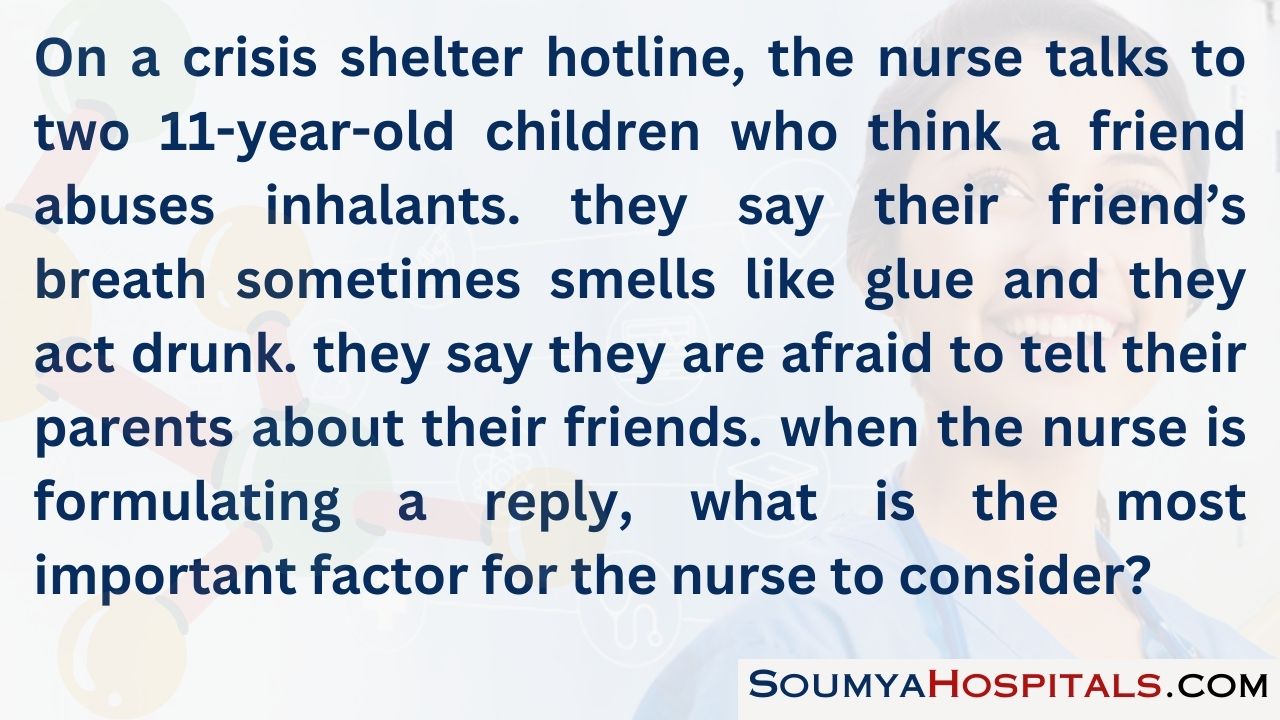
Explanation:
Telephoning the crisis shelter indicates that the boys are alarmed but are reluctant to talk with their parents. The boys may fear that their parents will assume that they have been abusing inhalants and punish them. The nurse should focus on helping the boys talk with their parents. The legality of using inhalants varies, but crisis hotlines are geared at providing supportive services. To prove that the observations are incorrect requires an intervention beginning with the boys’ parents. Inhalant abuse is a very dangerous, not minor, form of substance abuse.
Question 43.
While the nurse is teaching a group of volunteers for a crisis hotline, a volunteer asks, “What if I’m not sure why someone is calling?” Which statement by the nurse is most helpful?
(a) “Ask the caller to tell you why he or she is calling you today.”
(b) “Tell the caller to make an appointment at the walk-in crisis clinic.”
(c) “Instruct the caller to go to the nearest emergency department.”
(d) “Tell the caller to let you speak to anyone else in the house.”
Answer:
(a) “Ask the caller to tell you why he or she is calling you today.”
Explanation:
The crisis worker needs to use active focusing techniques to determine the crisis-precipitating event or the immediate problem. Asking the caller, "Why are you calling today?” or “What is the immediate problem?” will assist the caller in focusing on the specific need or event. Telling the client to make an appointment is inappropriate because the problem might be life-threatening. Telling the caller to go to the nearest emergency department is precipitous and may be unnecessary. Asking to speak to someone else in the home may be futile because the caller might be alone. This action also ignores the caller and his or her feelings.
Question 44.
After teaching a group of students who are volunteering for a local crisis hotline, the nurse judges that further education about crisis and intervention is needed when a student makes which statement?
(a) “Callers to a crisis line use this service when they are overwhelmed and exhausted.”
(b) “People use crisis hotlines when they are in the most pain and nothing is working for them.”
(c) “Most people in crisis will be calling the line once every day for at least a year. ”
(d) “One benefit is that a person will know how to handle stressful situations better in the future.”
Answer:
(c) “Most people in crisis will be calling the line once every day for at least a year. ”
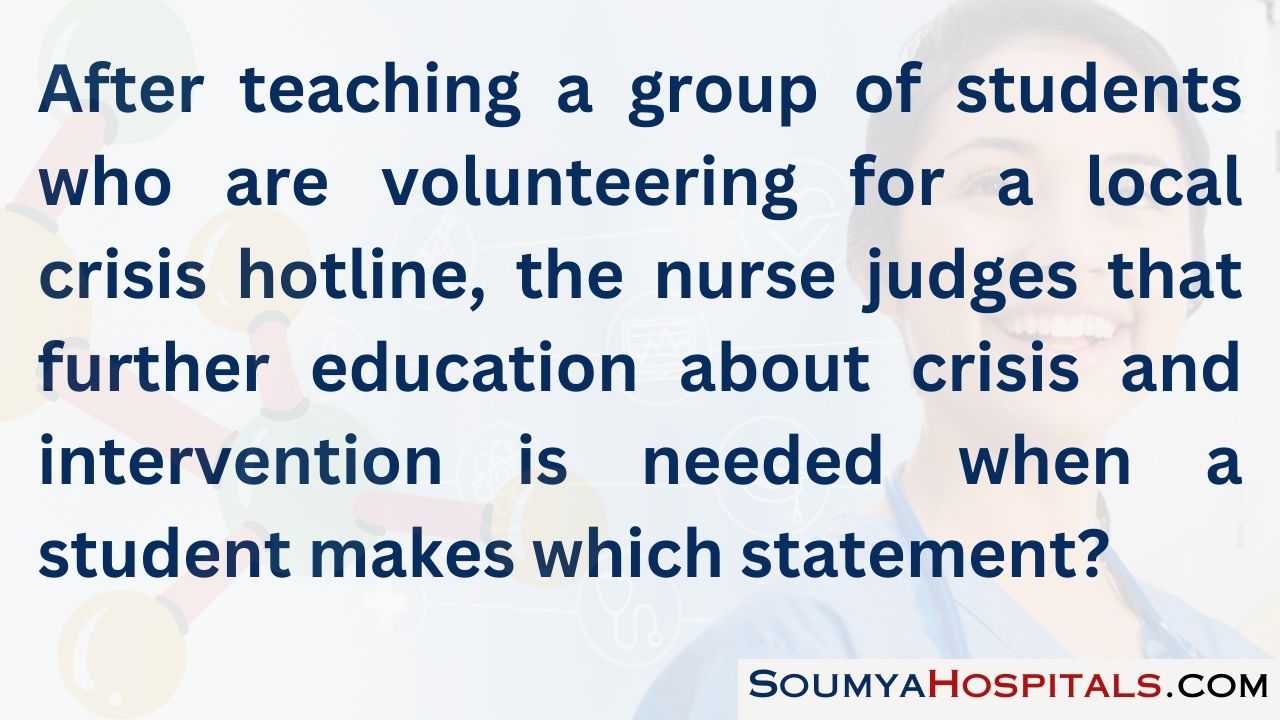
Explanation:
The concern that someone may call the crisis hotline every day for a year indicates that further understanding of crisis and crisis intervention is needed. A crisis situation is time-limited, typically resolving in 4 to 6 weeks if handled effectively. If a person calls the line daily for a year, that person has not been properly dealt with or is probably in a highly disorganized state requiring an alternative intervention.
The nurse needs to further review and clarify the material presented. Callers are typically in pain, overwhelmed, and exhausted when they call. A crisis can help an individual cope better in the future if the individual learns to handle the situation.
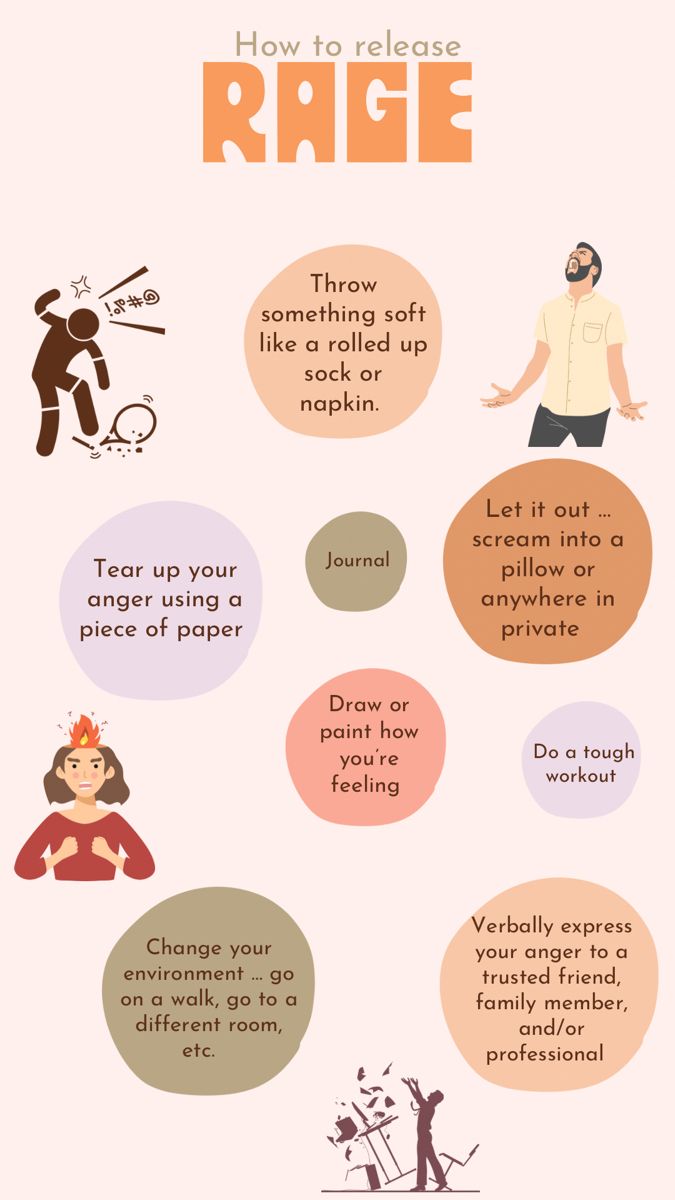
Question 45.
A client has just lost her husband in an apparent suicide. In the emergency department, the client tells the nurse that she has never lost an immediate family member and “feels so numb right now.” Which response by the nurse is best?
(a) “He is no longer suffering.”
(b) “Maybe you can take a trip somewhere he didn’t want to go.”
(c) “It’s better this way that he is not on a ventilator.”
(d) “His death will be a terrible loss.”
Answer:
(d) “His death will be a terrible loss.”
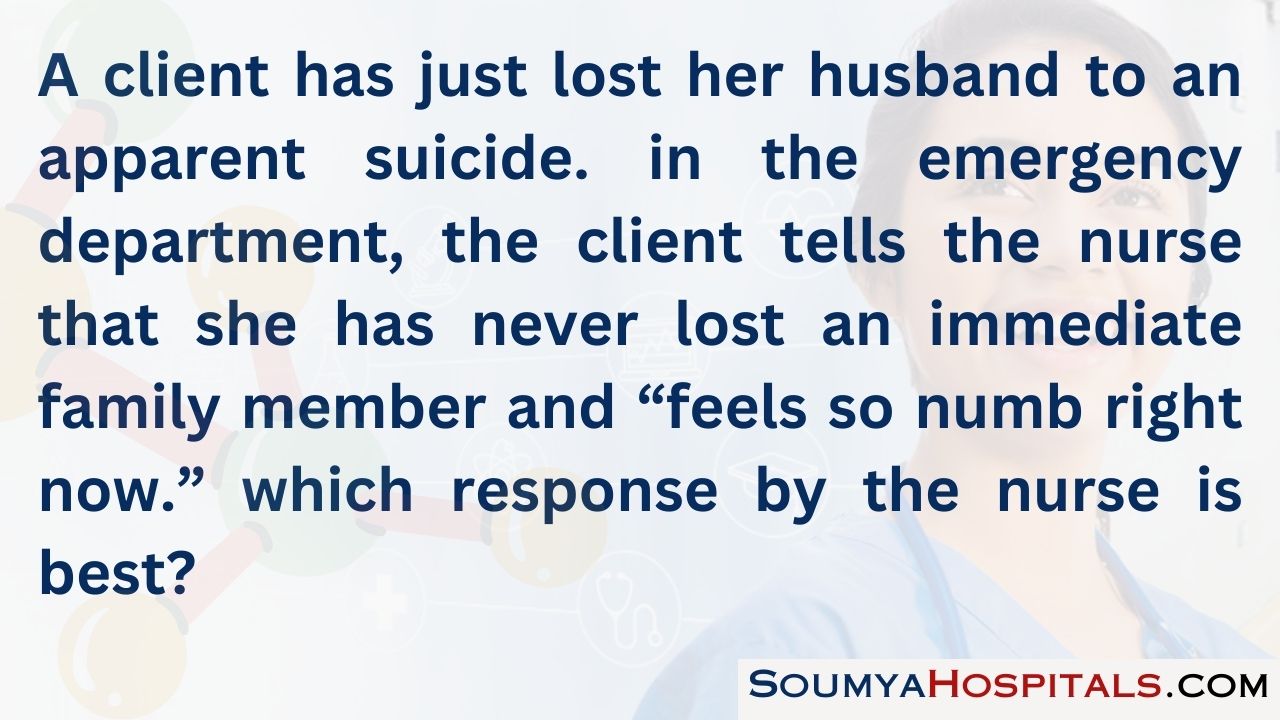
Explanation:
The statement that his death will be a terrible loss validates the bereaved person’s sense of loss and communicates the message that she is understood and supported. The other statements are unhelpful and banal responses at the time of a loss.
Question 46.
A true crisis state, involving a period of severe disorganization, is difficult to endure emotionally and physically. The nurse recognizes that a client will only be able to tolerate being in crisis for how long?
(a) 1 to 2 weeks
(b) 4 to 6 weeks
(c) 12 to 14 weeks
(d) 24 to 26 weeks
Answer:
(b) 4 to 6 weeks
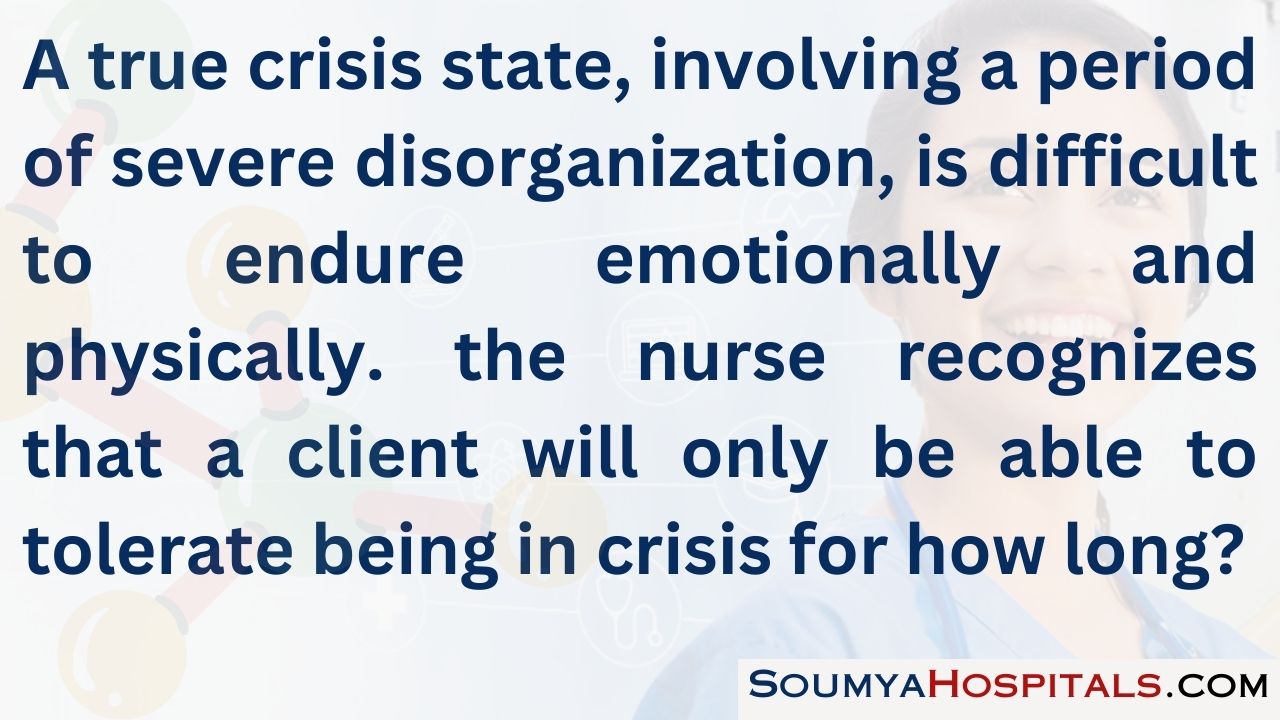
Explanation:
Generally, 4 to 6 weeks is viewed as the length of time a client can tolerate the severe level of disturbance of a true crisis. In the first week or two, the client usually is still trying to use normal coping skills and support systems. After 6 weeks of continuous crisis, a client is probably becoming so physically and emotionally drained that the client has sought or has been brought by others for medical or psychiatric care.
Question 47.
The nurse incorporates the underlying premise of crisis intervention, about providing “the right kind of help at the right time,” to achieve which initial goal?
(a) regaining emotional security and equilibrium
(b) resolution of underlying emotional problems
(c) development of insight and personal growth
(d) formulation of more effective support systems
Answer:
(a) regaining emotional security and equilibrium
Explanation:
The initial goal in crisis intervention is to help the client regain emotional security and equilibrium. Resolution of the underlying emotional problems, development of insight and personal growth, and formulation of more effective support systems are goals to address as the crisis subsides.
Question 48.
The nurse understands that with the right help at the right time, a client can successfully resolve a crisis and function better than before the crisis, based primarily on which factor?
(a) relinquishment of dysfunctional coping
(b) reestablishment of lost support systems
(c) acquisition of new coping skills
(d) gain of crisis prevention knowledge
Answer:
(c) acquisition of new coping skills
Explanation:
Learning new coping skills is the majo.r factor necessary for higher functioning. Better coping is likely to lead to regaining support systems, giving up dysfunctional coping, and awareness of how to prevent future crises.
Question 49.
A client is being discharged after 3 days of hospitalization for a suicide attempt that followed the receipt of a divorce notice. Which client finding indicates to the nurse that the client is ready for discharge?
(a) expresses a readiness for discharge
(b) has the names and phone numbers of two divorce lawyers
(c) has a list of support persons and community resources
(d) displays emotional stability
Answer:
(c) has a list of support persons and community resources
Explanation:
The risk of suicide can persist for 2 to 3 months even after a crisis has abated. Therefore, it is important for the client to be able to verbalize information about appropriate support persons and community resources and to have this in formation readily available. Although the client may state feeling ready to be discharged, this is nor the most reliable indicator. A divorce lawyer may not be appropriate at this point. At 3 days after a suicide attempt, emotional stability is not likely.
Question 50.
A distraught father is waiting for his son to come out of surgery. He accidentally backed car into his son, causing multiple fractures anserious head injury. Which statement by the would most alert the nurse to the need for atric consultation?
(a) "My son will be fine, but I may be charged with reckless driving".
(b) "This accident will probably cost memy marriage".
(c) "I just did not see him run behind the car".
(d) "If he dies, there will be nothing for me to do but join him".
Answer:
(d) "If he dies, there will be nothing for me to do but join him".
Explanation:
The statement about joining the son if he dies indicates potential for self-harm and subsequent suicide, always a risk during crisis. Although the father may be charged with reckless driving, this is not an indication for a psychiatric consultation. Verbalizing that the accident may lead to divorce may or may not be a real risk; however, this situation is not urgent. The statement about not seeing the son run behind the car illustrates the father’s attempts at trying to process the situation.
Question 51.
A grandson calls the crisis center expressing concern about his grandmother, who lost her husband a month ago. He states, “She’s been in bed for a week and is not eating or showering. She told me that she didn’t want to kill herself, but it’s not like her to do nothing for herself. She won’t even talk
to me when I visit her.” The nurse encourages the grandson to bring his grandmother to the center for evaluation based on which reason?
(a) The behaviors may reflect passive suicidal thoughts.
(b) The behaviors reflect altered role performance.
(c) Seeing the grandson and grandmother together will be helpful.
(d) Refusing to talk to the grandson alone indicates a major problem.
Answer:
(a) The behaviors may reflect passive suicidal thoughts.
Explanation:
Passive suicidal thoughts, such as a wish to die or giving up on self-care, can be as much of a risk as active suicidal ideation (the idea of killing one’s self directly), especially for older clients because they commonly lack the means, energy, and motivation for an active suicide attempt. Seeing the grandson and grandmother together may help later. Not talking to the grandson and experiencing altered role performance may be real issues, but these are not as critical as the risk of indirect (passive) suicide.
Question 52.
An adolescent client who is being seen by the crisis nurse after making several superficial cuts on her wrist states that all her friends are siding with her ex-boyfriend and will not talk to her anymore. She says she knows that the relationship is over, but “If I can’t have him, no one else will.” Which client problem takes the highest priority?
(a) situational low self-esteem
(b) risk for other-directed violence
(c) risk for suicide
(d) risk-prone health behavior
Answer:
(b) risk for other-directed violence
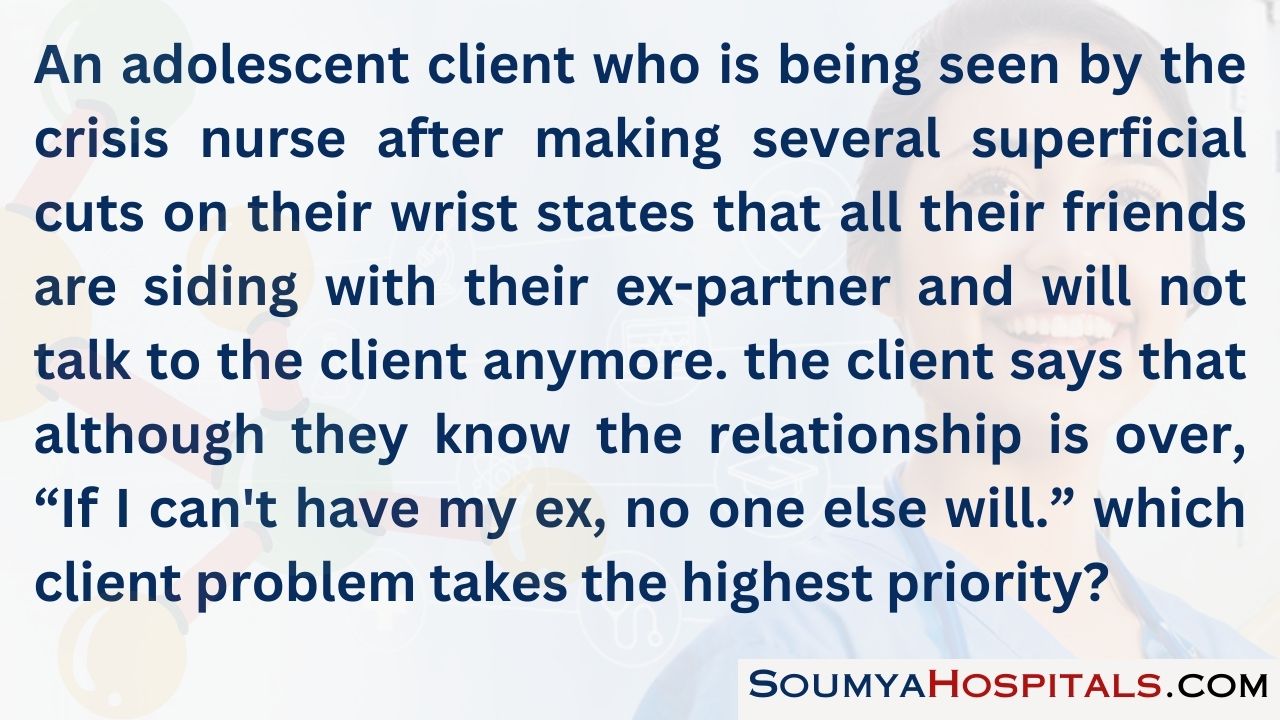
Explanation:
The threat toward the ex-boyfriend is the most immediate concern now, as the client turns her anger toward him instead of herself. Although situational low self-esteem, risk for suicide, and risk-prone health behavior are evident, these problems are less of a concern at this time.
Question 53.
A client who comes to the crisis center in a very distressed state tells the nurse, “I just can’t get over being fired last week. I’ve asked for help. I’ve talked to friends. I’ve tried everything to get through this, but nothing is working. Help me!” Which initial crisis intervention strategy should the nurse use?
(a) referral for counseling
(b) support system assessment
(c) emotion management
(d) unemployment assistance
Answer:
(c) emotion management
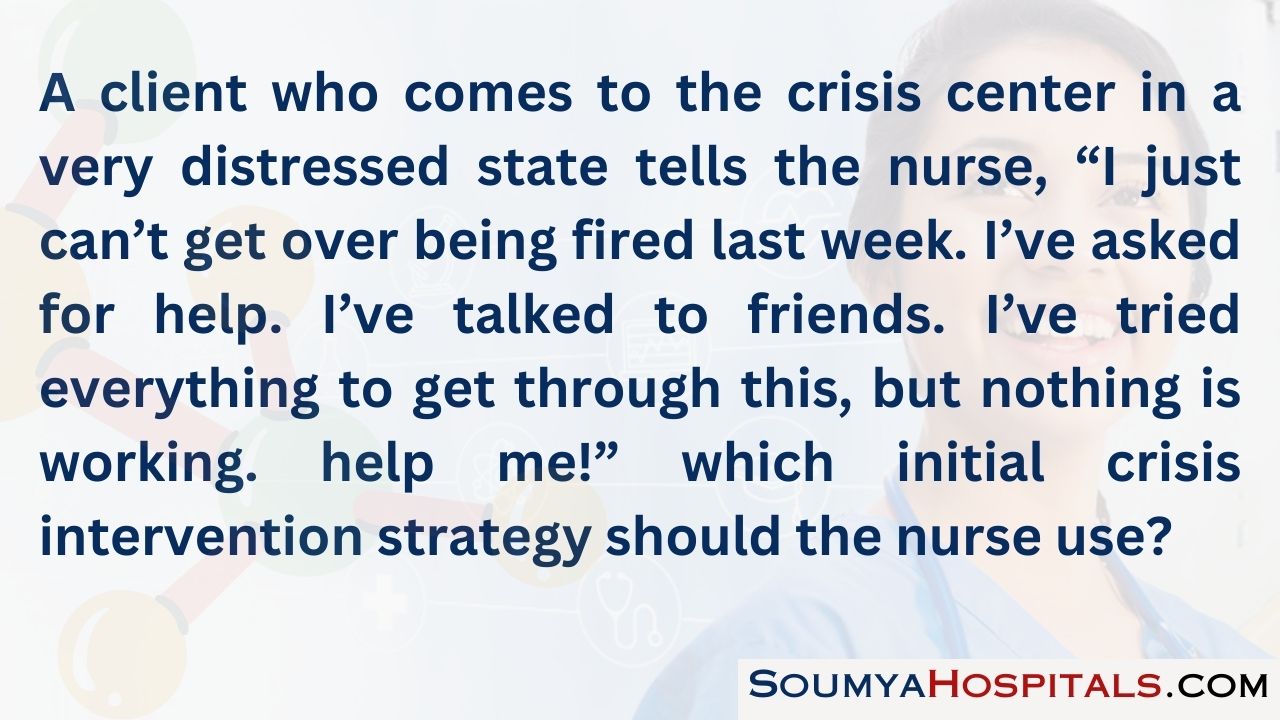
Explanation:
Letting the client express feelings (emotion management) is essential before trying to solve the problem or deciding what kind of referral is appropriate. A referral for counseling, assessment of the client’s support system, and unemployment assistance may be appropriate after the client’s anxiety is reduced.
Question 54.
A major role in crisis intervention is getting a client’s family and friends involved in helping with the immediate crisis as soon as possible. The nurse should determine that the support persons are prepared to help when they verbalize what information?
(a) the name and phone number of the client’s health care provider
(b) emergency resources and when to use them
(c) the coping strategies they are using
(d) long-term solutions they plan to tell the client to use
Answer:
(b) emergency resources and when to use them
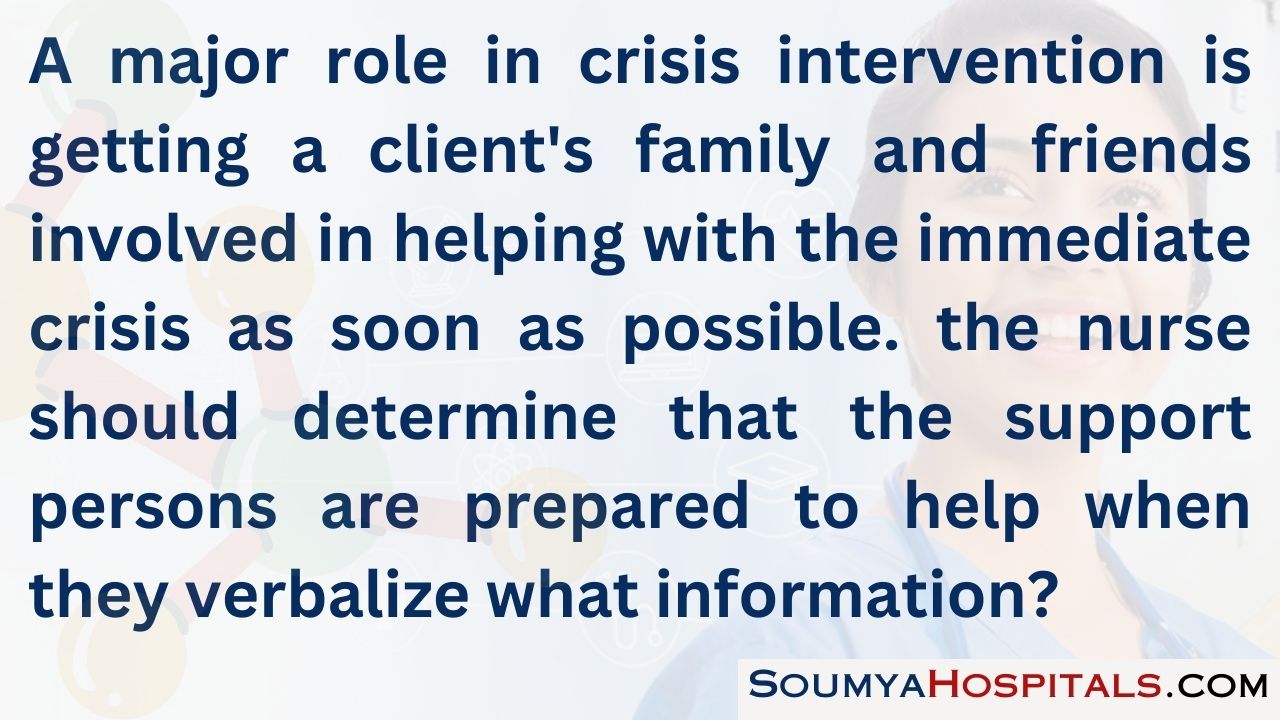
Explanation:
During a crisis, support persons demonstrate preparedness to help the client by verbalizing the emergency resources available and knowing when to use them. Follow-up medical care may be helpful as the crisis subsides. The coping strategies used by the support persons may or may not be relevant to the client’s needs and situation. Long-term solutions and advice may or may not be appropriate. The foe rs needs to be on the client’s immediate needs and situation.
Question 55.
During the interview at a crisis center, a newly widowed client reveals the wish “to join my husband in Heaven.” The nurse determines that the client does not plan to hurt herself. Which question is appropriate to use next?
(a) “Tell me what feelings you’ve been experiencing.”
(b) “Have you considered taking antidepressants?”
(c) “What was the cause of your husband’s death?”
(d) “Do you have children who are willing to help you?”
Answer:
(a) “Tell me what feelings you’ve been experiencing.”
Explanation:
The nurse needs to focus on the client and address her feelings. Talking about her feelings helps to decrease the risk of self-harm. Doing so takes precedence over questions about the cause of death and her children’s support. Antidepressant medications may be indicated, but more information is needed about the client’s emotional state.
Question 56.
A client was experiencing marital discord with a spouse of 4 years. When the spouse walked out, the client became angry and began to throw things and break dishes. A friend talked the client into seeking help at the local mental health center. Which of these questions should the nurse ask initially to begin to assess this client’s immediate problem?
(a) “Do you feel in control of yourself at this time?”
(b) “What did you do to cause your spouse to leave?”
(c) “In hindsight, how might you have managed this situation differently?”
(d) “What led you to come in for help today?”
Answer:
(d) “What led you to come in for help today?”
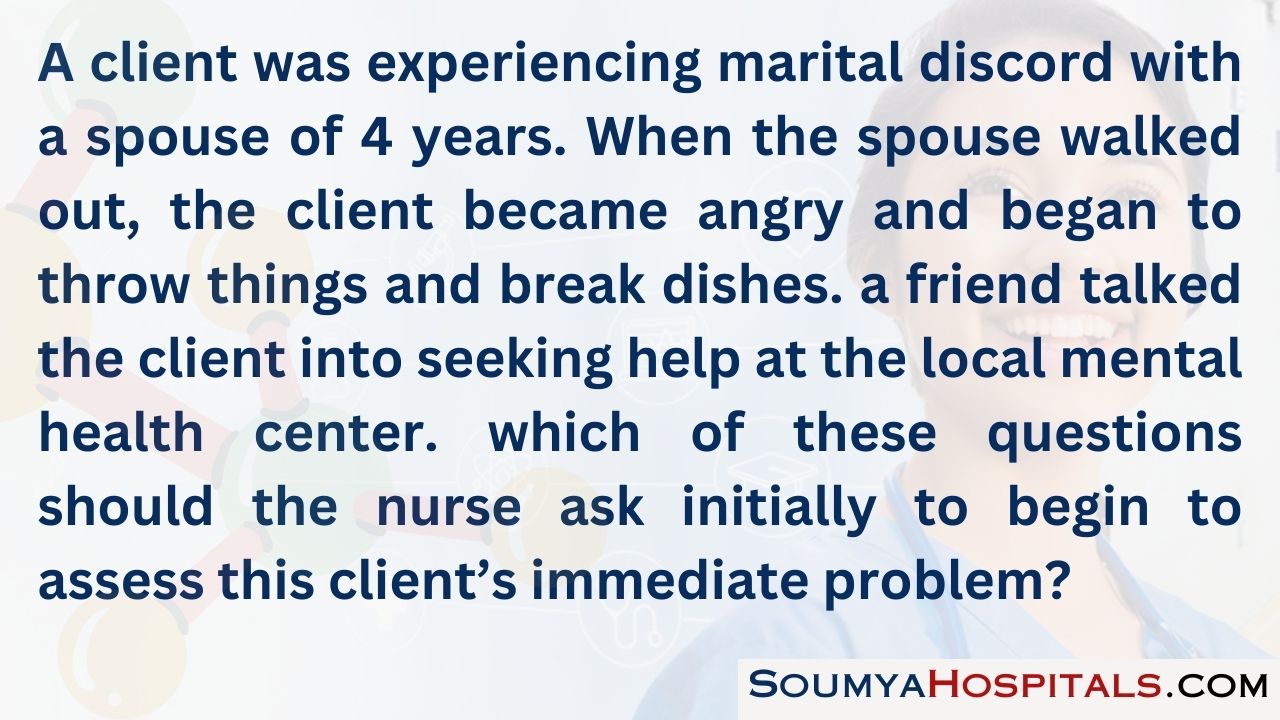
Explanation:
Beginning with an open-ended question that brings out the client’s view of his situation and reasons for seeking treatment is the most neutral beginning and helps to gain the client’s perception of events. Blaming the client for problems is accusatory and nonproductive. A time for reviewing what could have been done differently will come later.
Question 57.
A client is being admitted to a psychiatric outpatient program for counseling for ongoing emotional symptoms. Asked to rate the severity of the depression, anxiety, and anger that the client is feeling, the client states, “I don’t have any anger any more. I lost my temper once and nearly hurt my spouse. I never got angry again.” In which order of priority from first to last should the principles related to anger be shared with this client? All options must be used.
(a) “You can learn effective ways to discus
(b) “Anger is a natural emotion occurring in all human relationships.”
(c) “Holding your anger inside contributes to your depression.”
(d) “Unexpressed anger has a negative effect on the human body and mind.”
Answer:
(b) “Anger is a natural emotion occurring in all human relationships.”
(d) “Unexpressed anger has a negative effect on the human body and mind.”
(c) “Holding your anger inside contributes to your depression.”
(a) “You can learn effective ways to discus
Explanation:
(b), (d), (c), (a) Clients need to understand that anger is a normal emotion and if it is not expressed it can have negative effects on the body and mind. Then, the nurse should begin to focus on the client’s personal situation and help the client understand that holding in anger can aggravate depressive symptoms as well. One focus of outpatient counseling will be learning safe, effective ways to express anger.
Question 58.
The parent of a soldier who was killed 2 days ago is admitted after a serious suicide attempt. The client is medically stable, and a safety plan is in place. During a talk with the nurse, the client says, “Terrorism and war are holding me and the whole world hostage. It’s so unfair. I would rather be dead than live alone in constant fear.” Which nursing interventions are important in the next few days? Select all that apply.
(a) discussing effective ways to express justifiable anger
(b) teaching stress management and relaxation techniques
(c) identifying community groups for relatives of military personnel
(d) recommending an antiwar advocacy group
(e) strategizing about ways to increase a personal sense of security
Answer:
(a) discussing effective ways to express justifiable anger
(b) teaching stress management and relaxation techniques
(c) identifying community groups for relatives of military personnel
(e) strategizing about ways to increase a personal sense of security
Explanation:
(a), (b), (c), (e)Dealing with anger, stress, and anxiety; identifying resources and support groups; and increasing a sense of safety and security are appropriate interventions at this time. However, recommending an antiwar advocacy group may or may not be appropriate, even much later in the client’s recovery.
Question 59.
In developing a plan of care for a client who has had previous episodes of angry verbal outbursts, the nurse plans to take an educational approach to the problem. Arrange the steps the nurse should take from first to last. All options must be used.
(a) Assist the client to recognize the early cues of anger.
(b) Help the client identify triggers for anger.
(c) Practice with the client appropriate ways to express anger.
(d) Identify alternate ways to express anger.
Answer:
(b) Help the client identify triggers for anger.
(a) Assist the client to recognize the early cues of anger.
(d) Identify alternate ways to express anger.
(c) Practice with the client appropriate ways to express anger.
Explanation:
(b), (a), (d), (c) Angry clients may not realize what makes them angry and the cues that their behavior is becoming out of control. The nurse should first help the client identify what triggered the anger. Once the cause of the anger and cues to the loss of control are discovered, the nurse should assist the client in identifying safe and appropriate alternative expressions of anger and then practice those techniques prior to facing a real anger-producing situation.
Question 60.
The treatment team recommends that a client take an assertiveness training class offered in the hospital. Which behavior indicates that the client is becoming more assertive?
(a) The client arrives late for unit activities, and when asked about the lateness, the client says, “Because I feel like it!”
(b) The client asks the nurse to call the client’s employer about obtaining insurance.
(c) The client asks a roommate to put away dirty clothes because the untidiness bothers the client.
(d) The client follows the nurse’s advice of asking the health care provider (HCPj about being passive-aggressive.
Answer:
(c) The client asks a roommate to put away dirty clothes because the untidiness bothers the client.
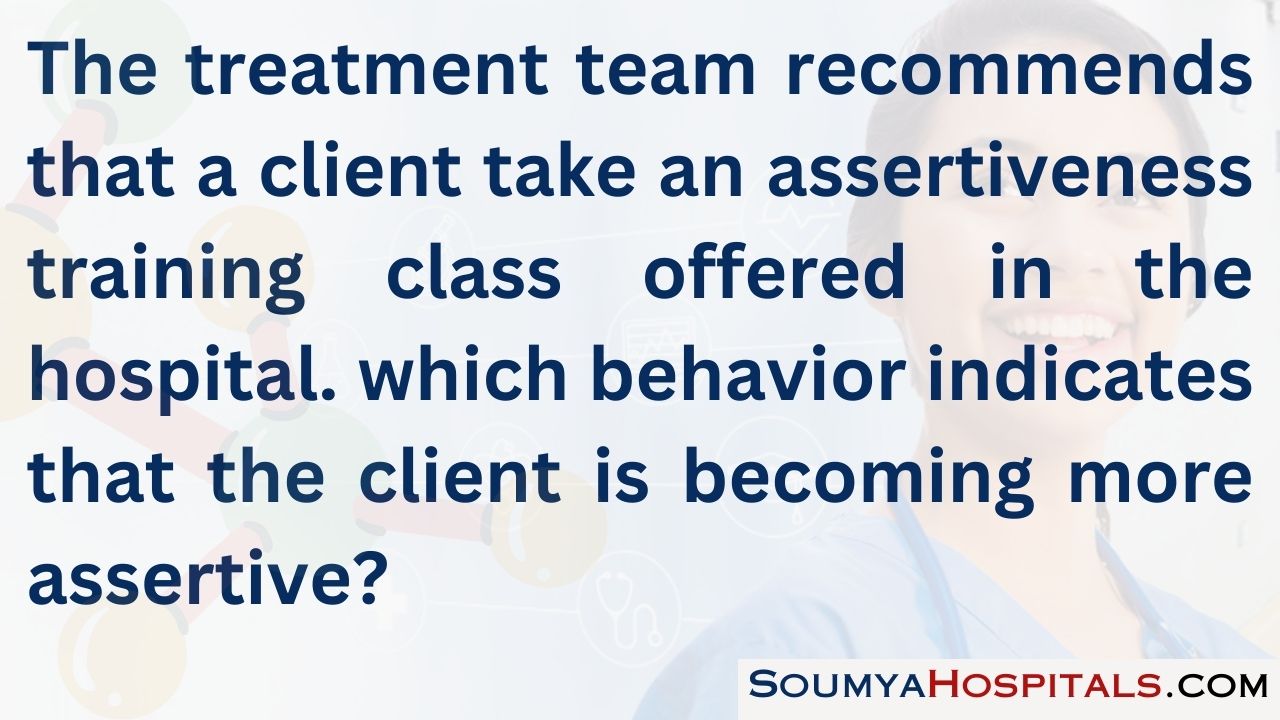
Explanation:
By requesting that the roommate respect the client’s rights (asking the roommate to put the dirty clothes on the floor away after telling him that this bothers him), the client is asserting himself. Arriving late is commonly passive resistance and thus not an indicator that the client is becoming assertive. Asking the nurse to call is dependent behavior. Although asking the HCP is more assertive, the client is relying on the nurse’s direction to do so.
Question 61.
The nurses assess a client for physiologic responses to stress. Which finding would suggest to the nurse that the client is not experiencing anger?
(a) increased respiratory rate
(b) decreased blood pressure
(c) increased muscle tension
(d) decreased peristalsis
Answer:
(b) decreased blood pressure
Explanation:
Blood pressure, as well as respiratory rate and muscle tension, increases during anger because of the autonomic nervous system response to epinephrine secretion. Peristalsis decreases.
Question 62.
When planning the care of a client experiencing aggression, the nurse incorporates the principle of “least restrictive alternative,” meaning that less restrictive interventions must be tried before more restrictive measures are employed. What measures should the nurse consider to be the most restrictive?
(a) tension reduction strategies
(b) haloperidol given orally
(c) voluntary seclusion or time-out
(d) haloperidol given intramuscularly
Answer:
(d) haloperidol given intramuscularly
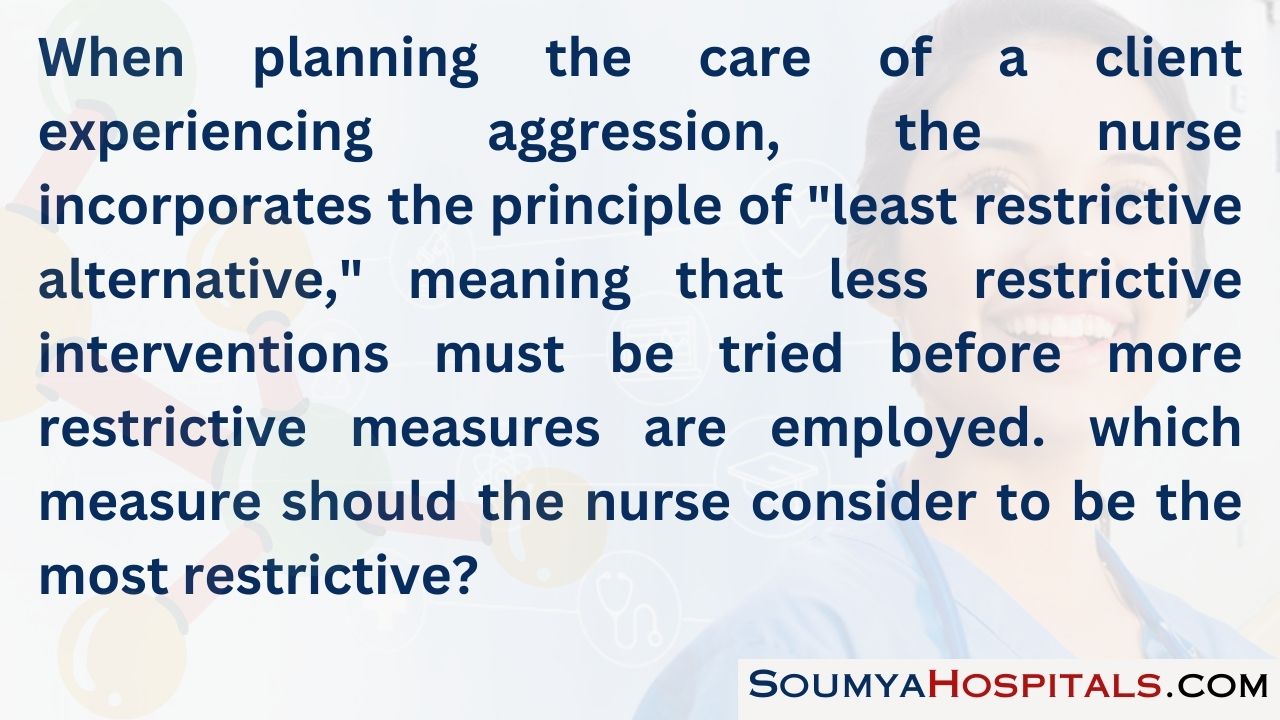
Explanation:
When given intramuscularly, haloperidol is considered most restrictive because it is intrusive and a client usually does not receive the drug voluntarily. Oral haloperidol is considered less restrictive because the client usually accepts the pill voluntarily. Tension reduction strategies and voluntary seclusion are considered less restrictive because they are not intrusive and the client usually consents to their use.
Question 63.
As an angry client becomes more agitated while talking about problems, the nurse decides to ask for staff assistance in taking control of the situation when the client demonstrates which behavior?
(a) swearing about a spouse’s behaviors when discussing marital problems
(b) picking up a pool cue stick and telling the nurse to get out of the way
(c) making a fist and pounding loudly on the table
(d) coming out of the room instead of staying in time-out
Answer:
(b) picking up a pool cue stick and telling the nurse to get out of the way
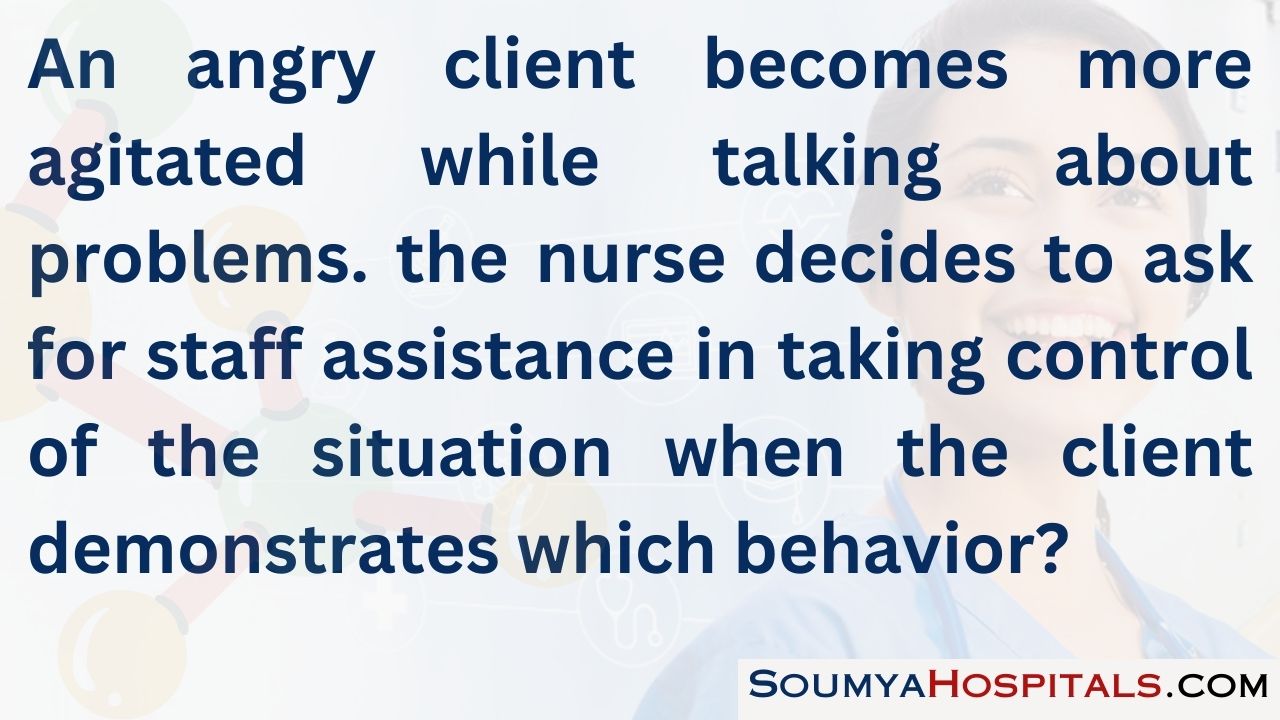
Explanation:
Asking the staff for assistance is appropriate when the client demonstrates behaviors that involve the direct threat of violence. Holding a stick and telling the nurse to move is the most direct threat of violence. Swearing and pounding on a table may be disturbing, but these actions are less of a threat. Coming out of his room may indicate noncompliance with directions. However, further assessment is needed to determine whether this behavior was a direct threat of violence.
Question 64.
The nurse is advising a client with schizophrenia about what to do when beginning to get agitated. The client has been compliant with taking medications and has worked with clinic staff on dealing with the illness and recognizing feelings of agitation. Indicate the order from first to last in which the nurse should suggest the actions be taken. All options must be used.
(a) "Take your oral lorazepam."
(b) "Take your oral haloperidol".
(c) "Go to a quiet place".
(d) "Tell trusted people that you are becoming upset".
Answer:
(c) "Go to a quiet place".
(d) "Tell trusted people that you are becoming upset".
(a) "Take your oral lorazepam."
(b) "Take your oral haloperidol".
Explanation:
(c), (d), (a), (b) Since external stimuli can greatly contribute to agitation, the nurse should teach the client that the first step is to go to a quiet area, enlist the help of others, and finally take medication. Taking the lorazepam first would help decrease anxiety quickly, thus diminishing agitation. If the lorazepam is not successful, the client could take oral haloperidol to help clear the client’s thoughts and decrease agitation.
Question 65.
When a client is about to lose control, the extra staff who come to help commonly stay at a distance from the client unless asked to move closer by the nurse who is talking to the client. What statement best explains the primary rationale for staying at a distance initially?
(a) The client is more likely to act out if there is an audience, even additional staff.
(b) The nurse talking to the client makes the decisions about other staff actions.
(c) The client is likely to perceive others as being closer than they are and feel threatened.
(d) When the extra staff is visible, the client is less likely to regain self-control.
Answer:
(c) The client is likely to perceive others as being closer than they are and feel threatened.
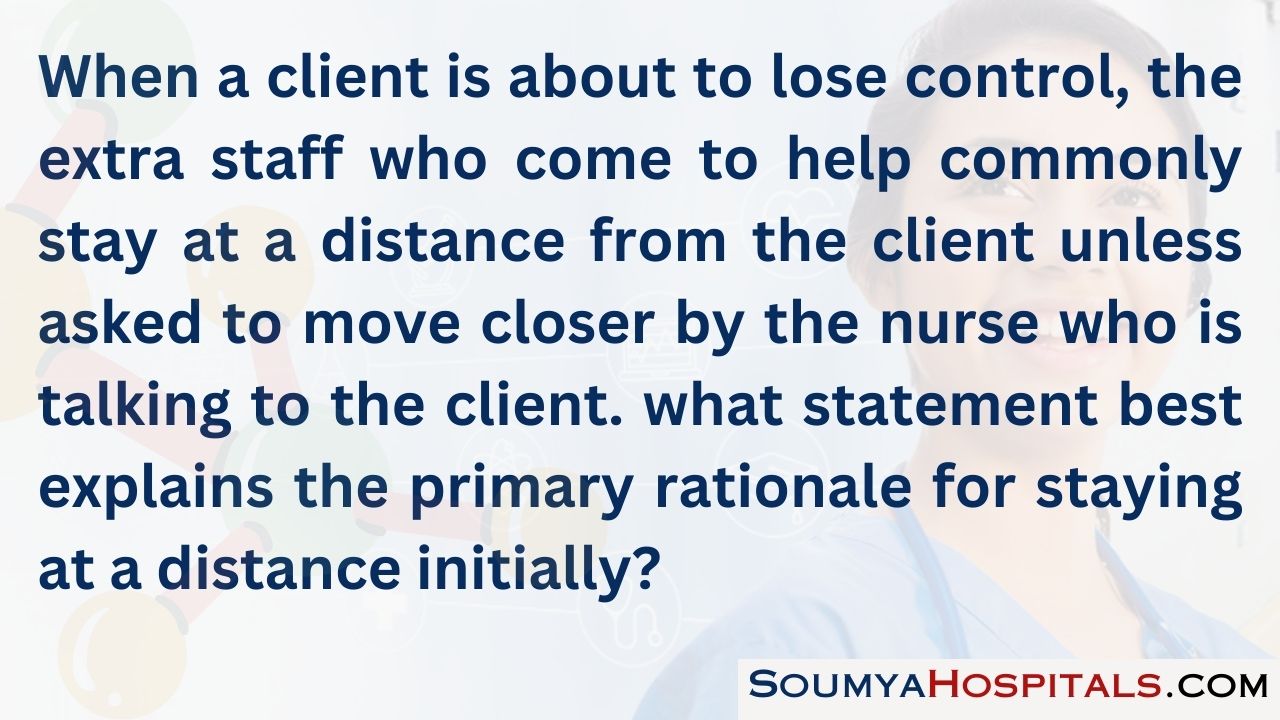
Explanation:
The client who is about to lose control is experiencing a high degree of anxiety or agitation, which alters the client’s ability to perceive reality. Initially, the client may feel threatened by the presence of others. A client who is out of control is not thinking about having an audience. Although the nurse with the client who is about to lose control is generally the one giving directions, this is not a rationale for staying at a distance. When seeing extra staff, the client may or may not be able to gain self-control.
Question 66.
When preparing to use seclusion as an alternative to restraint for a client who has not yet lost control, the nurse expects to use a room with limited furniture and no access to dangerous articles. What should the nurse also consider as critical for the safety of the client?
(a) a security window in the door or a room camera
(b) lights that can be dimmed from outside the room
(c) a staff member to stay in the room with the client
(d) a prescription for the seclusion before it is initiated
Answer:
(a) a security window in the door or a room camera
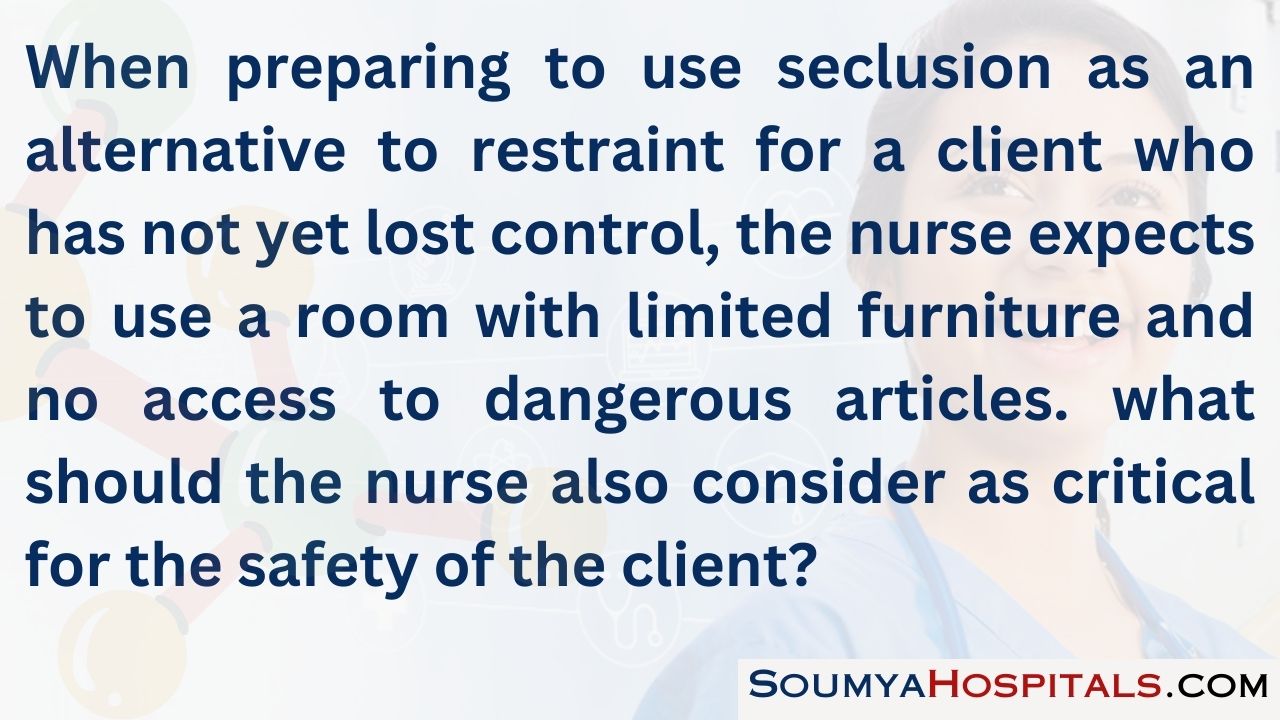
Explanation:
When using seclusion, the safety of the client is paramount. Therefore, staff must be able to see the client in seclusion at all times, such as through a security window in the door or with a room camera. Although outside access for dimming the lights to decrease stimuli may be appropriate, it is not critical for the client’s safety. Having one staff member stay in a room alone with a potentially violent client is unsafe. A prescription for seclusion can be obtained before or after it is initiated.
Question 67.
The nurse is required initially to restrain all four of a client’s extremities. For what reason would the nurse anticipate the need to add a full-length restraint blanket?
(a) The client states that restraints are tight and uncomfortable.
(b) The staff want extra protection for themselves.
(c) The client is at risk for injury from fighting the restraints.
(d) Staff assessment reveals that the client will feel more secure under the blanket.
Answer:
(c) The client is at risk for injury from fighting the restraints.
Explanation:
A full-length restraint blanket is added when the client is at risk for injury from fighting the restraints. The increased degree of restriction is justified only when the risk of client injury increases. Feeling more secure is not a sufficient cause for using a more restrictive measure. Client statements that restraints are tight and uncomfortable require the nurse to assess the situation and adjust the restraints if necessary to ensure adequate circulation. Four-way restraints already provide adequate protection for the staff.
Question 68.
Which nursing intervention is the highest priority when a client is placed in restraints?
(a) monitoring the client every 15 minutes
(b) assisting with nutrition and elimination
(c) performing range-of-motion exercises for each limb, one at a time
(d) changing the client’s position every 2 hours
Answer:
(a) monitoring the client every 15 minutes
Explanation:
Safety of the client and staff is the utmost priority. Therefore, the client must be monitored closely and frequently, such as every 15 minutes, to ensure that the client is safe and free from injury. Assisting with nutrition and elimination, performing range-of-motion exercises on each limb, and changing the client’s position every 2 hours are important after the safety of the client and staff is ensured by close, frequent monitoring.
Question 69.
According to hospital protocol, after a client is restrained, the staff meet and discuss the restraint situation. In addition to sharing feelings and offering support, what should the nurse identify as the long-term goal for the debriefing?
(a) providing feedback to each other on how procedures were handled
(b) comparing the perceptions of the various staff members
(c) deciding when to release the client from restraints
(d) improving the staff’s use of restraint procedures
Answer:
(d) improving the staff’s use of restraint procedures
Explanation:
The long-term goal of the debriefing after restraining a client is to improve aggression management procedures so that prevention of aggression improves and the frequency of restraint use decreases. Providing feedback and comparing options are single aspects that would eventually to the ultimate goal of improving aggression treatment procedures. When a client can be relearned restraints are not immediately predictable.
Question 70.
Based on a client’s history of violence toward others and inability to cope with anger, what should the nurse use as the most important indicator of goal achievement before discharge?
(a) acknowledgment of the client’s angry feelings
(b) ability to describe situations that provoke angry feelings
(c) development of a list of how anger has been handled in the past
(d) verbalization of feelings in an appropriate manner
Answer:
(d) verbalization of feelings in an appropriate manner
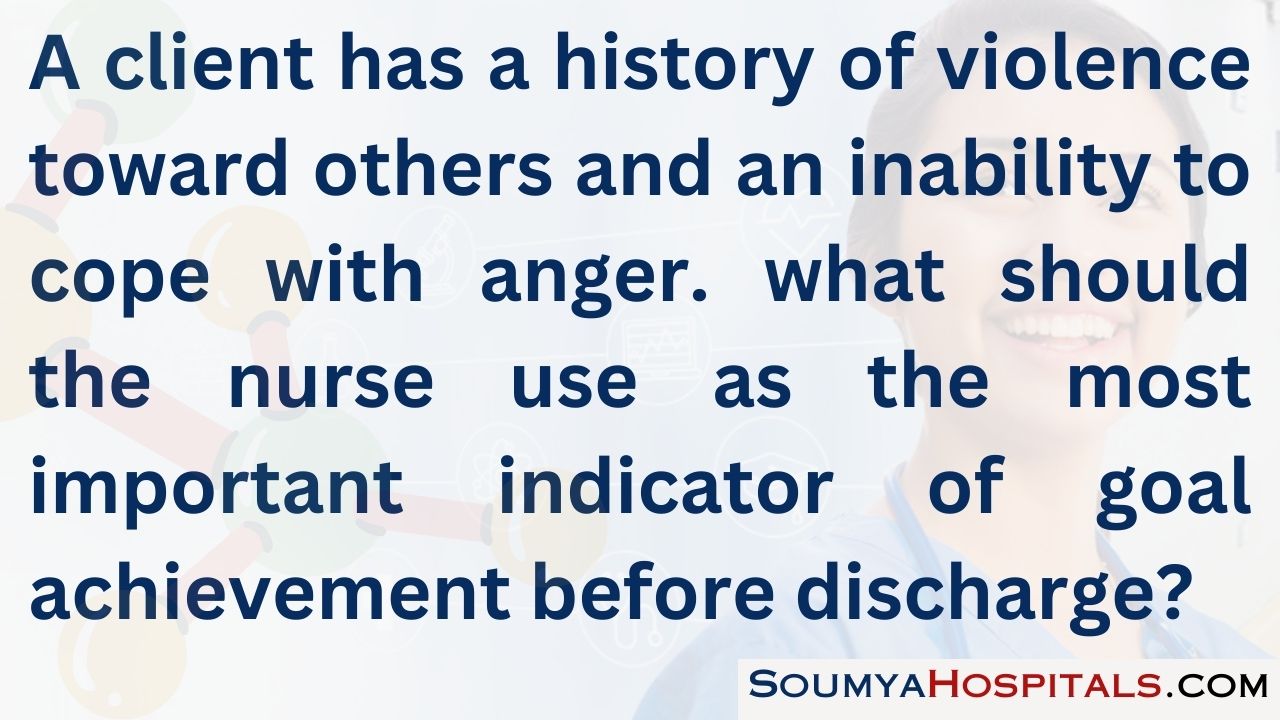
Explanation:
Verbalizing feelings, especially anger, in an appropriate manner is an A feelings method of coping that reduces the chance adaptive client will act out these feelings toward reduces the client’s ability to verbalize feelings to others a change in behavior, a crucial indicator of goal achievement. Although acknowledging feelings of anger and describing situations that precipitate angry feelings are important in helping the client reach her goal, they are not appropriate indicators that behavior has changed.
Asking the client to list how anger has been handled in the past is helpful if the nurse discusses coping methods with the client. However, based on this client’s history, this would not be helpful because the nurse and client are already aware of the client’s aggression toward others.
Question 71.
A client is admitted to the psychiatric hospital for evaluation after numerous incidents of threatening others, angry outbursts, and two episodes of hitting a coworker at the client’s place of employment. The client is very anxious and tells the nurse, “I didn’t mean to hit him. He made me so mad that I just couldn’t help it. I hope I don’t hit anyone here.” To ensure a safe environment, what should the nurse do first?
(a) Let other clients know that the client has a history of hitting others so that they will not provoke the client.
(b) Put the client in a private room, and limit the client’s time out of the room to when staff can be with the client.
(c) Tell the client that hitting others is unacceptable behavior, and ask the client to tell a staff member when feeling angry.
(d) Obtain a prescription for a medication to be administered to decrease the client’s anxiety and threatening behavior.
Answer:
(c) Tell the client that hitting others is unacceptable behavior, and ask the client to tell a staff member when feeling angry.
Explanation:
The nurse must clearly address behavioral expectations, such as telling the client that hitting is unacceptable, and also provide alternatives for the client, such as letting staff members know when the client begins to feel angry. Making others responsible for the client’s behavior or isolating the client in a room is inappropriate because it does not include the client in managing the behavior. Although medication may be helpful, this action does not give the client responsibility for the behavior and is not warranted at this time.
Question 72.
A client loses control and throws two chairs toward another client. What should the nurse do next?
(a) Ask the client to go to the quiet area and talk about the behavior.
(b) Administer an oral PRN tranquilizer and prepare for a show of determination.
(c) Process the incident with the client and discuss alternative behaviors.
(d) Call for assistance to restrain the client and administer a PRN intramuscular tranquilizer.
Answer:
(d) Call for assistance to restrain the client and administer a PRN intramuscular tranquilizer.
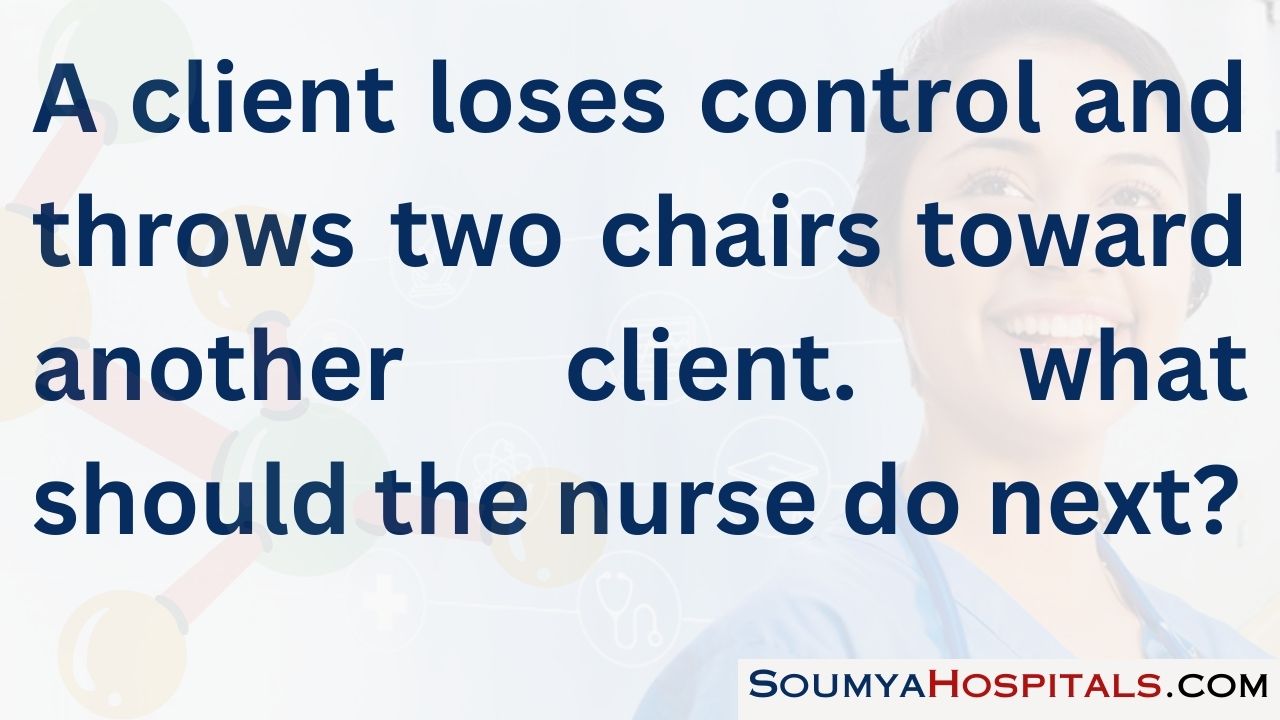
Explanation:
The client is in the crisis phase of the assault cycle. Therefore, the nurse must act immediately, using restraints and an intramuscular tranquilizer to prevent injury to others or further property damage. It is too late to ask the client to go to a quiet area to talk because the client’s behavior is past the triggering phase. Giving the client an oral tranquilizer and preparing for a show of determination are nursing interventions used in the escalation phase. Processing the incident with the client and discussing alternative behaviors are interventions used in the post-crisis phase.
Question 73.
A woman who was raped in her home was brought to the emergency department by her husband. After being interviewed by the police, the husband talks to the nurse. “I don’t know why she didn’t keep the doors locked like I told her. I can’t believe she’s had sex with another man now.” How should the nurse respond?
(a) “Let’s talk about how you feel. Maybe it would help to talk to other men who have been through this.”
(b) “Maybe the doors were locked, but the man broke in anyway.”
(c) “Your wife needs your support right now, not your criticism.”
(d) “It wasn’t consensual sex. Let’s see if your wife was physically injured.”
Answer:
(a) “Let’s talk about how you feel. Maybe it would help to talk to other men who have been through this.”
Explanation:
The nurse should respond to the husband’s needs and concerns and should offer support. Protecting or defending the wife against his criticism ignores the husband’s needs.
Question 74.
A 75-year-old woman was brought to the crisis center by her husband. The husband reports that his wife has been in shock and anxious since her purse was stolen outside of their home. The woman blames herself for being robbed, is worried about her stolen wallet and credit cards, and is afraid to go home. What nursing actions are indicated? Select all that apply.
(a) Request a prescription for lorazepam to decrease her anxiety.
(b) Encourage her to talk about the robbery and her feelings.
(c) Discuss what changes at home would help her feel safe.
(d) Investigate if she has physical injuries from the robbery.
(e) Ask her what she thinks she could have done to prevent the robbery.
Answer:
(b) Encourage her to talk about the robbery and her feelings.
(c) Discuss what changes at home would help her feel safe.
(d) Investigate if she has physical injuries from the robbery.
Explanation:
(b), (c), (d) After the impact of a crime, the client’s most important needs are for physical safety and emotional security. There is no indication that the client has a severe level of anxiety; therefore, lorazepam is not indicated. Asking her how she could have prevented the robbery implies that she could be at fault.
Question 75.
A 35-year-old has been killed as a result of a terrorist attack. What should the nurse advise the friends and relatives of the victim to do during the early stages of the recovery process? Select all that apply.
(a) Keep in contact with other family and friends.
(b) Attend memorial or religious services.
(c) Use relaxation techniques and physical activities.
(d) Speak out publicly about the impact of the loss.
(e) Attend community meetings with others who have lost loved ones.
Answer:
(a) Keep in contact with other family and friends.
(c) Use relaxation techniques and physical activities.
(e) Attend community meetings with others who have lost loved ones.
Explanation:
(a), (c), (e) Receiving support from family, friends, other survivors, and community services is generally helpful after such events. Relaxation and participation in activities help manage stress reactions. Speaking out publicly may or may not be helpful later in the recovery process but may actually hinder recovery in the early stages.
Question 76.
When the client is involuntarily committed to a hospital because the client is assessed as being dangerous to himself or others, which client rights are lost?
(a) the right to access health care
(b) the right to send and receive uncensored mail
(c) freedom from seclusion and restraints
(d) the right to leave the hospital against medical advice
Answer:
(d) the right to leave the hospital against medical advice
Explanation:
When a client is committed involuntarily, the right to leave against medical advice is forfeited. All the other rights are preserved unless there is further court action or a case of imminent danger to self or others (hitting staff, cutting self).
Question 77.
The nurse manager on a psychiatric unit is reviewing the outcomes of staff participation in an aggression management program. What indicator would the nurse use to evaluate the effectiveness of such a program?
(a) fewer client injuries during restraint procedures
(b) a reduction of complaints by clients’ relatives
(c) fewer staff injuries during restraint procedures
(d) a reduction in the total number of restraint procedures
Answer:
(d) a reduction in the total number of restraint procedures
Explanation:
The primary goal of an aggression management program is to prevent violence. This goal is evidenced by a reduction in the total number of restraint procedures used or needed. Although fewer client and staff injuries are important, these goals are secondary to prevention. Reduction in the number of complaints by clients’ relatives is affected by more variables than just restraint procedures.
Question 78.
A young woman has been stalked and then beaten by an ex-boyfriend. Treatment of her injuries is complete, and she is ready for discharge. What should the nurse do to ensure the woman’s safety and security prior to discharge? Select all that apply.
(a) Determine if the client knows the location of the ex-boyfriend.
(b) Ask if she plans to see the ex-boyfriend again.
(c) Provide information on resources and a safety plan.
(d) Ensure that she has a safe place to stay after discharge.
(e) Obtain consent to send her emergency department records to her family health care provider.
Answer:
(a) Determine if the client knows the location of the ex-boyfriend.
(b) Ask if she plans to see the ex-boyfriend again.
(c) Provide information on resources and a safety plan.
(d) Ensure that she has a safe place to stay after discharge.
Explanation:
(a), (b), (c), (d) The crucial interventions involve safety and support. Asking for consent is a health privacy issue, not a safety issue, and is not essential to the discharge process.
Question 79.
The nurse is planning care for a group of clients. Which client should the nurse identify as needing the most assistance in accepting being ill?
(a) an 8-year-old boy who alternately cries for his mother and is angry with the nurse about being hospitalized after a bike accident
(b) a 32-year-old woman diagnosed with depression related to lupus erythematosus who dis-cusses her medication’s adverse effects with the nurse
(c) a 45-year-old man who just suffered a severe myocardial infarction and talks to the nurse about concerns regarding resuming sexual relations with his wife
(d) a 60-year-old woman diagnosed with chronic obstructive pulmonary disease who refuses to wear an oxygen mask even though poor oxygenation makes her confused
Answer:
(d) a 60-year-old woman diagnosed with chronic obstructive pulmonary disease who refuses to wear an oxygen mask even though poor oxygenation makes her confused
Explanation:
The 60-year-old woman is acting in a way that worsens her physical and mental condition because she does not want to be sick. The 8-year-old child is acting normally for someone his age who is unexpectedly hospitalized. The cooperation demonstrated by the client with lupus and the client who had a myocardial infarction indicates a level of acceptance of their illnesses and of their role as being ill.
Question 80.
The nurse is managing the care for a client in a disaster shelter who broke a femur and has lost her family home in a hurricane. What measures should, the nurse take? Select all that apply.
(a) Supervise the care provided to the client during the crisis.
(b) Obtain a prescription for antipsychotic medications for the client.
(c) Act as a client advocate for the client incrisis.
(d) Discuss with the interdisciplinary to 3am available community resources for 'the client.
(e) Obtain accurate identification including name, age, address, contact information, and names of relatives.
Answer:
(a) Supervise the care provided to the client during the crisis.
(c) Act as a client advocate for the client incrisis.
(d) Discuss with the interdisciplinary to 3am available community resources for 'the client.
(e) Obtain accurate identification including name, age, address, contact information, and names of relatives.
Explanation:
(a), (c), (d), (e) The nurse who is managing the care of the client in a disaster shelter provides for the management of care by supervising the care for the client in crisis. In a disaster, the nurse also must be sure that the client is identified and contact information about the client is documented. The nurse also acts as a client advocate for the client in crisis and discusses available community resources for the client with the interdisciplinary team assigned to this client. There are no data to indicate that antipsychotic medications are needed for this client at this time.
Question 81.
During a meeting with nurse managers from the crisis intake unit, acute mental health unit, and mental health long-term care unit, the hospital risk manager says, “Approximately 57% of our client safety problems can be directly attributed to poor handoffs.” What solution might the nurse managers implement to improve these statistics?
(a) One nurse per shift should be responsible for receiving all medications that are delivered from pharmacy.
(b) Nursing staff should complete a checklist to take more care in interpreting primary health care provider prescriptions.
(c) Nursing staff should complete and document admission history and physicals within one hour of arrival on a unit.
(d) Initiate a template of transfer information to be communicated when a client is transferred from one care setting to another.
Answer:
(d) Initiate a template of transfer information to be communicated when a client is transferred from one care setting to another.
Explanation:
Handoffs occur when a client is transferred from one care setting to another, or from one caregiver to another. Use of a template to standardize the information communicated at the time of transfer can address safety concerns. Handoffs are not associated with admission H&Ps, although clinical guidelines often play a part in initiating care. Health care provider checklists may impact safety but are not part of the hand off process. Delivery of medications from the pharmacy
Question 82.
The nurse teaches a client about the benefits of participation in self-help groups. What information does the nurse include in the teaching plan? Select all that apply.
(a) It increases knowledge about mental illness.
(b) It develops stronger social networks and support.
(c) It is more cost-effective than hospitalization.
(d) It increases the client’s sense of well-being.
(e) It facilitates the development of advocacy skills.
Answer:
(a) It increases knowledge about mental illness.
(b) It develops stronger social networks and support.
(d) It increases the client’s sense of well-being.
Explanation:
(a), (b), (d) Participation in self-help groups has been shown to increase knowledge, coping skills, self-esteem, confidence, sense of well-being, and a sense of being in control. Improving social and support networks is also a common outcome of client engagement in self-help groups. If symptoms are severe and/or life-threatening, hospitalization may be the most appropriate and as a result potentially more cost-effective. The development of personal advocacy skills is not a primary outcome of client participation in self-help groups.
Question 83.
During a unit meeting attended by clients and staff, several clients criticized their primary nurses. These clients have also been intimidating two other clients who have recently been admitted to the unit, and now, the new clients have stopped sharing their opinions during the meeting. What is the first action for the nurse to take?
(a) Help the new clients express the reasons they have stopped sharing their ideas.
(b) Ask the clients criticizing their nurses to suggest some possible solutions for the practices they are criticizing.
(c) Give the clients who are publicly criticizing the nurses a verbal warning that this behavior is riot acceptable.
(d) Use' the next unit meeting to discuss respect and the importance of collaboration with the treatment team.
Answer:
(b) Ask the clients criticizing their nurses to suggest some possible solutions for the practices they are criticizing.
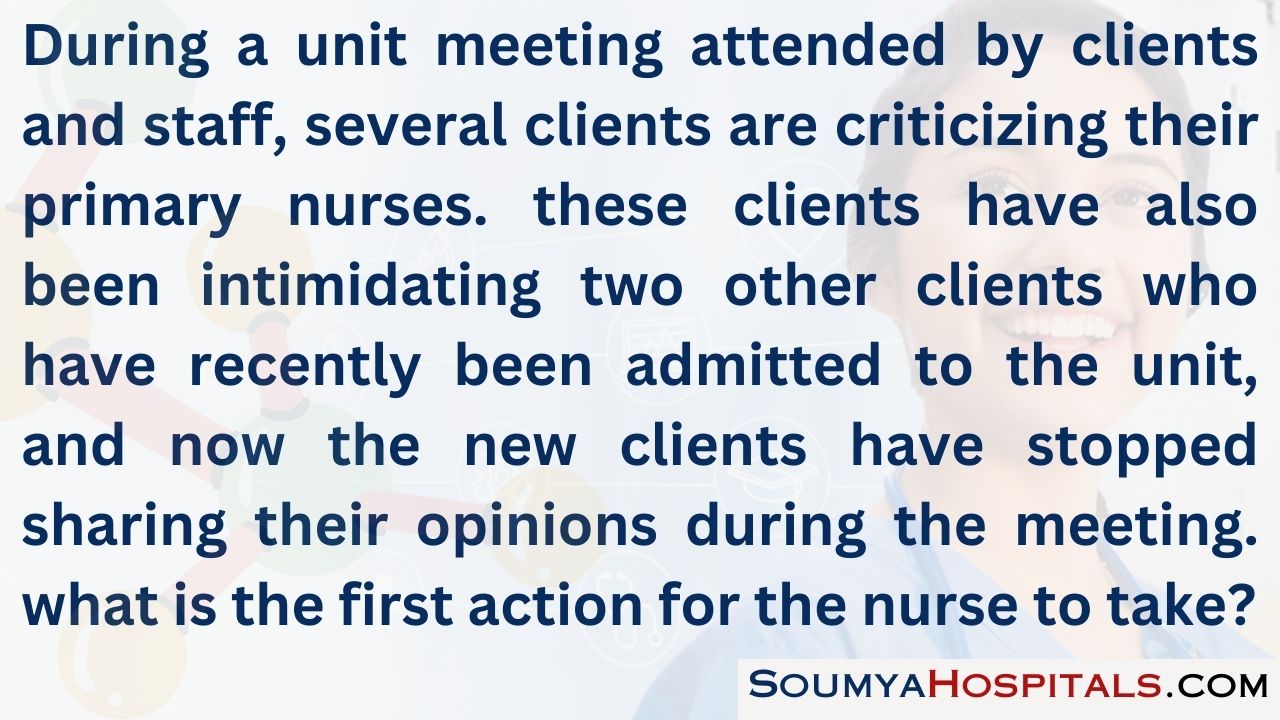
Explanation:
Recognizing that the clients are part of the solution to the issues they are presenting demonstrates a client-centered approach to care. Having the new clients challenge the behaviors of other clients does not facilitate the development of a therapeutic milieu. Warning clients that behaviors are unacceptable reinforces a sense of client powerlessness and does not build a therapeutic relationship. Discussing respect and collaboration would happen after the criticisms have been acknowledged and the clients have been asked for their opinions.
Question 84.
Two nurses disagree on what is the most important information for a client with a stress-related illness to have during a discharge teaching session. How should the nurse assigned to provide the discharge teaching proceed?
(a) Share all the information that both nurses thought was important.
(b) Review the policies related to required discharge teaching.
(c) Be aware of different interpretations and personal biases held by nurses.
(d) Ask the client what is most important for them as they prepare for discharge.
Answer:
(d) Ask the client what is most important for them as they prepare for discharge.
Explanation:
The discharge teaching session will be most effective if the nurse uses a client-centered approach to better assess what the client needs and, therefore, what information to share. Sharing all the information does not respect the knowledge that the client already has. Reviewing the policies is one area to help identify important areas for teaching, but in order to ensure that client needs are met, further assessment is required. Awareness of personal biases should not be used to determine what is important for the client.
Question 85.
Despite education and role-play practice of restraint procedures, a staff member is injured when actually restraining a client. When helping the uninjured staff deal with the incident, the nurse should address which factor?
(a) The emotional responses may be similar to those of other crime victims.
(b) The member is likely to resign after experiencing such an injury.
(c) Legal action against the client will take time and energy.
(d) The member must debrief with the assaultive client before returning.
Answer:
(a) The emotional responses may be similar to those of other crime victims.
Explanation:
Being injured by a client can result in emotional responses similar to those of other crime victims. A resignation after being injured is relatively rare. Legal action against the client is sometimes discussed but rarely initiated. Debriefing with the client may be inappropriate or unnecessary to resolve the situation.
Question 86.
A nurse calls the unit manager to report that her purse has been stolen from the locked break room. The nurse says she thinks she knows which of the staff stole the purse. Which actions by the nurse manager would be appropriate? Select all that apply.
(a) Confront the person the nurse suspects stole the purse.
(b) Call hospital security to initiate an investigation.
(c) Ask the nurse to document all the facts related to the stolen purse.
(d) Alert nursing administration that a staff purse has been stolen.
(e) Ask other staff to report any suspicious activity they may have observed.
Answer:
(b) Call hospital security to initiate an investigation.
(c) Ask the nurse to document all the facts related to the stolen purse.
(d) Alert nursing administration that a staff purse has been stolen.
(e) Ask other staff to report any suspicious activity they may have observed.
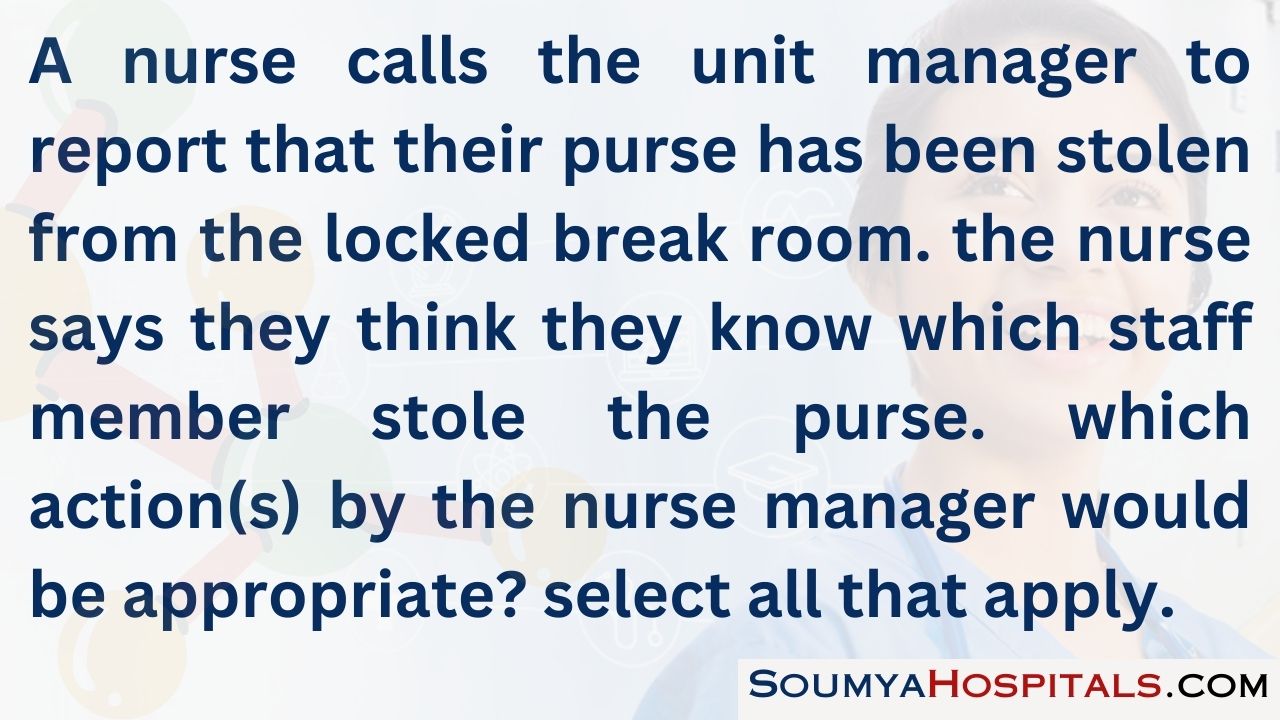
Explanation:
(b), (c), (d) (e) It is appropriate for the nurse manager to initiate a security investigation and ask the nurse to document all the facts about the missing purse. Alerting nursing administration is required. Seeking information from other staff will help with the investigation. It is inappropriate to confront any possible suspects while the investigation is ongoing.
Question 87.
A nurse’s ex-boyfriend enters the unit and states, “If I can’t have her, then no one will.” Hospital security escorts him out of the building and warns him not to return. The unit manager holds a staff meeting to confirm that which workplace violence policies and procedures will be implemented? Select all that apply.
(a) Give a quick overview of the hospital’s workplace violence policies and procedures.
(b) Offer counseling for the nurse and any other staff threatened by her ex-boyfriend.
(c) Work with security and the nurse to initiate workplace precautions related to the ex-boyfriend.
(d) Ask security to help the nurse understand how to initiate a protective order against her ex-boyfriend.
(e) Ask the nurse to take a leave of absence until her ex-boyfriend is notified of the protective order.
Answer:
(a) Give a quick overview of the hospital’s workplace violence policies and procedures.
(b) Offer counseling for the nurse and any other staff threatened by her ex-boyfriend.
(c) Work with security and the nurse to initiate workplace precautions related to the ex-boyfriend.
(d) Ask security to help the nurse understand how to initiate a protective order against her ex-boyfriend.
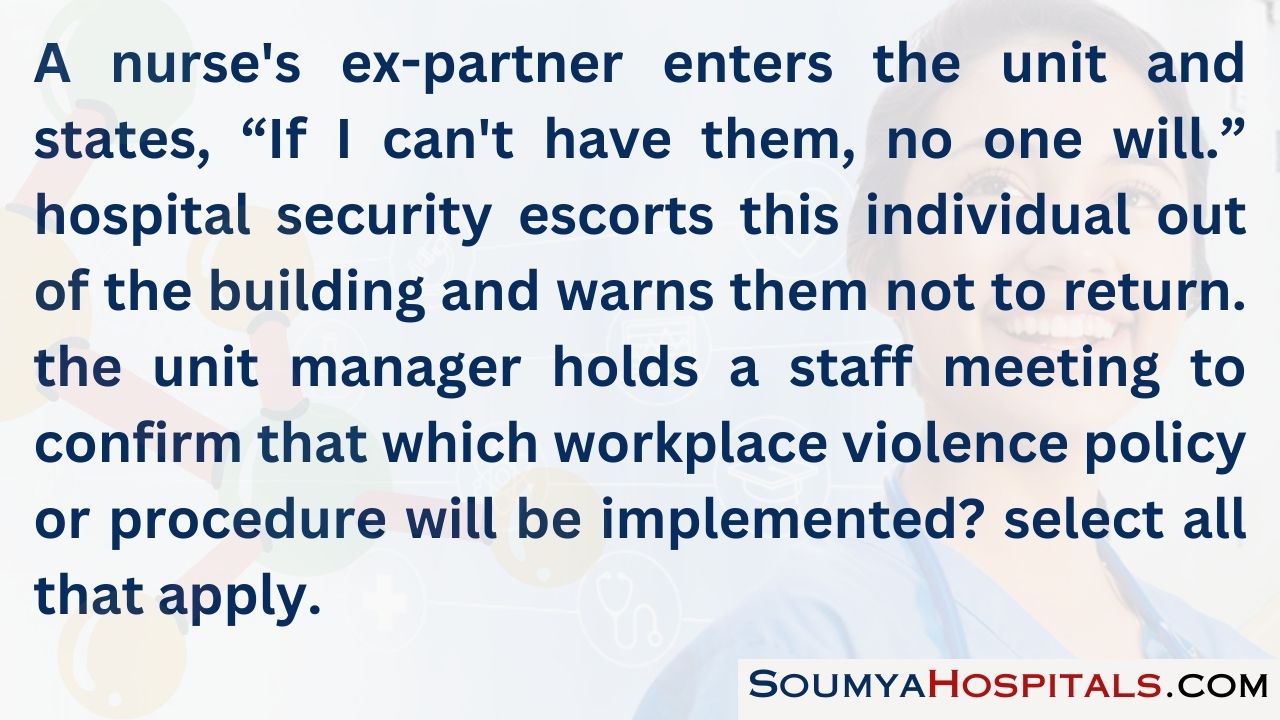
Explanation:
(a), (b), (c), (d) National guidelines exist for managing workplace violence. Unit staff, hospital administration, and hospital security personnel develop and enforce the resulting policies. These include training all staff about workplace violence, processes for reporting of such violence, and counseling for the staff victim. Protecting staff and clients may include posting the ex-boyfriend’s picture at employee entrances and a protective order initiated by the nurse. With these policies and procedures in place, it is counterproductive to ask the nurse to take a leave of absence.
Read More:
